Apollo
| Apollo | |
|---|---|
God of oracles, healing, archery, music and arts, light, knowledge, herds and flocks, and protection of the young | |
| Member of the Twelve Olympians and the Dii Consentes | |
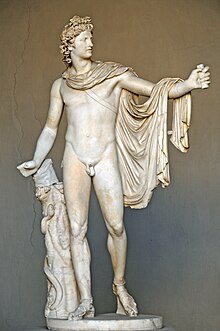 Apollo Belvedere, c. 120–140 CE | |
| Abode | Mount Olympus |
| Planet | Sun Mercury[1] (antiquity) |
| Animals | Raven, swan, wolf |
| Symbol | Lyre, laurel wreath, python, bow and arrows |
| Tree | laurel, cypress |
| Day | Sunday (hēmérā Apóllōnos) |
| Mount | A chariot drawn by swans |
| Genealogy | |
| Born | |
| Parents | Zeus and Leto |
| Siblings | Artemis (twin), and many paternal half-siblings |
| Children | Asclepius, Aristaeus, Corybantes, Hymen, Apollonis, Amphiaraus, Anius, Apis, Cycnus, Eurydice, Hector, Linus of Thrace, Lycomedes, Melaneus, Melite, Miletus, Mopsus, Oaxes, Oncius, Orpheus, Troilus, Phemonoe, Philammon, Tenerus, Trophonius, and various others |
| Equivalents | |
| Etruscan | Apulu |
| Hittite | Apaliunas |
| Egyptian | Horus |
| Phoenician | Resheph[2] |
| Celtic | Grannus |
| Part of a series on |
| Ancient Greek religion |
|---|
 |
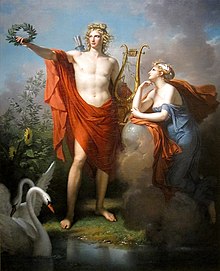
Apollo[a] is one of the Olympian deities in classical Greek and Roman religion and Greek and Roman mythology. Apollo has been recognized as a god of archery, music and dance, truth and prophecy, healing and diseases, the Sun and light, poetry, and more. One of the most important and complex of the Greek gods, he is the son of Zeus and Leto, and the twin brother of Artemis, goddess of the hunt. He is considered to be the most beautiful god and is represented as the ideal of the kouros (ephebe, or a beardless, athletic youth). Apollo is known in Greek-influenced Etruscan mythology as Apulu.[3]
As the patron deity of Delphi (Apollo Pythios), Apollo is an oracular god—the prophetic deity of the Delphic Oracle and also the deity of ritual purification. His oracles were often consulted for guidance in various matters. He was in general seen as the god who affords help and wards off evil, and is referred to as Alexicacus, the "averter of evil".
Medicine and healing are associated with Apollo, whether through the god himself or mediated through his son Asclepius. Apollo delivered people from epidemics, yet he is also a god who could bring ill health and deadly plague with his arrows. The invention of archery itself is credited to Apollo and his sister Artemis. Apollo is usually described as carrying a silver or golden bow and a quiver of silver or golden arrows.
As the god of mousike,[b] Apollo presides over all music, songs, dance, and poetry. He is the inventor of string-music and the frequent companion of the Muses, functioning as their chorus leader in celebrations. The lyre is a common attribute of Apollo. Protection of the young is one of the best attested facets of his panhellenic cult persona. As a kourotrophos, Apollo is concerned with the health and education of children, and he presided over their passage into adulthood. Long hair, which was the prerogative of boys, was cut at the coming of age (ephebeia) and dedicated to Apollo. The god himself is depicted with long, uncut hair to symbolise his eternal youth.
Apollo is an important pastoral deity, and he was the patron of herdsmen and shepherds. Protection of herds, flocks and crops from diseases, pests and predators were his primary rustic duties. On the other hand, Apollo also encouraged the founding of new towns and the establishment of civil constitutions, is associated with dominion over colonists, and was the giver of laws. His oracles were often consulted before setting laws in a city. Apollo Agyieus was the protector of the streets, public places and home entrances.[4]
In Hellenistic times, especially during the 5th century BCE, as Apollo Helios he became identified among Greeks with Helios, the personification of the Sun.[5] Although Latin theological works from at least 1st century BCE identified Apollo with Sol,[6][7] there was no conflation between the two among the classical Latin poets until 1st century CE.[8]
Etymology

Apollo (Attic, Ionic, and Homeric Greek: Ἀπόλλων, Apollōn (GEN Ἀπόλλωνος); Doric: Ἀπέλλων, Apellōn; Arcadocypriot: Ἀπείλων, Apeilōn; Aeolic: Ἄπλουν, Aploun; Latin: Apollō)
The name Apollo—unlike the related older name Paean—is generally not found in the Linear B (Mycenean Greek) texts, although there is a possible attestation in the lacunose form ]pe-rjo-[ (Linear B: ]𐀟𐁊-[) on the KN E 842 tablet,[9][10][11] though it has also been suggested that the name might actually read "Hyperion" ([u]-pe-rjo-[ne]).[12]
The etymology of the name is uncertain. The spelling Ἀπόλλων (pronounced [a.pól.lɔːn] in Classical Attic) had almost superseded all other forms by the beginning of the common era, but the Doric form, Apellon (Ἀπέλλων), is more archaic, as it is derived from an earlier *Ἀπέλjων. It probably is a cognate to the Doric month Apellaios (Ἀπελλαῖος),[13] and the offerings apellaia (ἀπελλαῖα) at the initiation of the young men during the family-festival apellai (ἀπέλλαι).[14][15] According to some scholars, the words are derived from the Doric word apella (ἀπέλλα), which originally meant "wall," "fence for animals" and later "assembly within the limits of the square."[16][17] Apella (Ἀπέλλα) is the name of the popular assembly in Sparta,[16] corresponding to the ecclesia (ἐκκλησία). R. S. P. Beekes rejected the connection of the theonym with the noun apellai and suggested a Pre-Greek proto-form *Apalyun.[18]
Several instances of popular etymology are attested by ancient authors. Thus, the Greeks most often associated Apollo's name with the Greek verb ἀπόλλυμι (apollymi), "to destroy".[19] Plato in Cratylus connects the name with ἀπόλυσις (apolysis), "redemption", with ἀπόλουσις (apolousis), "purification", and with ἁπλοῦν ([h]aploun), "simple",[20] in particular in reference to the Thessalian form of the name, Ἄπλουν, and finally with Ἀειβάλλων (aeiballon), "ever-shooting". Hesychius connects the name Apollo with the Doric ἀπέλλα (apella), which means "assembly", so that Apollo would be the god of political life, and he also gives the explanation σηκός (sekos), "fold", in which case Apollo would be the god of flocks and herds.[21] In the ancient Macedonian language πέλλα (pella) means "stone,"[22] and some toponyms may be derived from this word: Πέλλα (Pella,[23] the capital of ancient Macedonia) and Πελλήνη (Pellēnē/Pellene).[24]
The Hittite form Apaliunas (dx-ap-pa-li-u-na-aš) is attested in the Manapa-Tarhunta letter.[25] The Hittite testimony reflects an early form *Apeljōn, which may also be surmised from the comparison of Cypriot Ἀπείλων with Doric Ἀπέλλων.[26] The name of the Lydian god Qλdãns /kʷʎðãns/ may reflect an earlier /kʷalyán-/ before palatalization, syncope, and the pre-Lydian sound change *y > d.[27] Note the labiovelar in place of the labial /p/ found in pre-Doric Ἀπέλjων and Hittite Apaliunas.
A Luwian etymology suggested for Apaliunas makes Apollo "The One of Entrapment", perhaps in the sense of "Hunter".[28]
Greco-Roman epithets
Apollo's chief epithet was Phoebus (/ˈfiːbəs/ FEE-bəs; Φοῖβος, Phoibos Greek pronunciation: [pʰó͜i.bos]), literally "bright".[29] It was very commonly used by both the Greeks and Romans for Apollo's role as the god of light. Like other Greek deities, he had a number of others applied to him, reflecting the variety of roles, duties, and aspects ascribed to the god. However, while Apollo has a great number of appellations in Greek myth, only a few occur in Latin literature.
Sun
- Aegletes (/əˈɡliːtiːz/ ə-GLEE-teez; Αἰγλήτης, Aiglētēs), from αἴγλη, "light of the Sun"[30]
- Helius (/ˈhiːliəs/ HEE-lee-əs; Ἥλιος, Helios), literally "Sun"[31]
- Lyceus (/laɪˈsiːəs/ ly-SEE-əs; Λύκειος, Lykeios, from Proto-Greek *λύκη), "light". The meaning of the epithet "Lyceus" later became associated with Apollo's mother Leto, who was the patron goddess of Lycia (Λυκία) and who was identified with the wolf (λύκος).[32]
- Phanaeus (/fəˈniːəs/ fə-NEE-əs; Φαναῖος, Phanaios), literally "giving or bringing light"
- Phoebus (/ˈfiːbəs/ FEE-bəs; Φοῖβος, Phoibos), literally "bright", his most commonly used epithet by both the Greeks and Romans
- Sol (Roman) (/sɒl/), "Sun" in Latin
Wolf
- Lycegenes (/laɪˈsɛdʒəniːz/ ly-SEJ-ən-eez; Λυκηγενής, Lukēgenēs), literally "born of a wolf" or "born of Lycia"
- Lycoctonus (/laɪˈkɒktənəs/ ly-KOK-tə-nəs; Λυκοκτόνος, Lykoktonos), from λύκος, "wolf", and κτείνειν, "to kill"
Origin and birth
Apollo's birthplace was Mount Cynthus on the island of Delos.
- Cynthius (/ˈsɪnθiəs/ SIN-thee-əs; Κύνθιος, Kunthios), literally "Cynthian"
- Cynthogenes (/sɪnˈθɒdʒɪniːz/ sin-THOJ-in-eez; Κυνθογενής, Kynthogenēs), literally "born of Cynthus"
- Delius (/ˈdiːliəs/ DEE-lee-əs; Δήλιος, Delios), literally "Delian"
- Didymaeus (/ˌdɪdɪˈmiːəs/ DID-im-EE-əs; Διδυμαῖος, Didymaios) from δίδυμος, "twin", as the twin of Artemis
Place of worship
Delphi and Actium were his primary places of worship.[33][34]
- Acraephius (/əˈkriːfiəs/ ə-KREE-fee-əs; Ἀκραίφιος, Akraiphios, literally "Acraephian") or Acraephiaeus (/əˌkriːfiˈiːəs/ ə-KREE-fee-EE-əs; Ἀκραιφιαίος, Akraiphiaios), "Acraephian", from the Boeotian town of Acraephia (Ἀκραιφία), reputedly founded by his son Acraepheus.[35]
- Actiacus (/ækˈtaɪəkəs/ ak-TY-ə-kəs; Ἄκτιακός, Aktiakos), literally "Actian", after Actium (Ἄκτιον)
- Delphinius (/dɛlˈfɪniəs/ del-FIN-ee-əs; Δελφίνιος, Delphinios), literally "Delphic", after Delphi (Δελφοί). An etiology in the Homeric Hymns associated this with dolphins.
- Epactaeus, meaning "god worshipped on the coast", in Samos.[36]
- Pythius (/ˈpɪθiəs/ PITH-ee-əs; Πύθιος, Puthios, from Πυθώ, Pythō), from the region around Delphi
- Smintheus (/ˈsmɪnθjuːs/ SMIN-thewss; Σμινθεύς, Smintheus), "Sminthian"—that is, "of the town of Sminthos or Sminthe"[37] near the Troad town of Hamaxitus[38]
- Napaian Apollo (Ἀπόλλων Ναπαῖος), from the city of Nape at the island of Lesbos[39]
- Eutresites, from the city of Eutresis.[40]

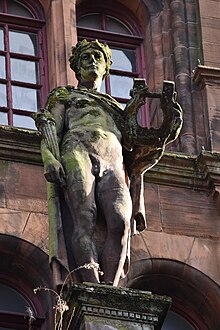
Healing and disease
- Acesius (/əˈsiːʒəs/ ə-SEE-zhəs; Ἀκέσιος, Akesios), from ἄκεσις, "healing". Acesius was the epithet of Apollo worshipped in Elis, where he had a temple in the agora.[41]
- Acestor (/əˈsɛstər/ ə-SESS-tər; Ἀκέστωρ, Akestōr), literally "healer"
- Culicarius (Roman) (/ˌkjuːlɪˈkæriəs/ KEW-lih-KARR-ee-əs), from Latin culicārius, "of midges"
- Iatrus (/aɪˈætrəs/ eye-AT-rəs; Ἰατρός, Iātros), literally "physician"[42]
- Medicus (Roman) (/ˈmɛdɪkəs/ MED-ik-əs), "physician" in Latin. A temple was dedicated to Apollo Medicus in Rome, probably next to the temple of Bellona.
- Paean (/ˈpiːən/ PEE-ən; Παιάν, Paiān), physician, healer[43]
- Parnopius (/pɑːrˈnoʊpiəs/ par-NOH-pee-əs; Παρνόπιος, Parnopios), from πάρνοψ, "locust"
Founder and protector
- Agyieus (/əˈdʒaɪɪjuːs/ ə-JUY-ih-yooss; Ἀγυιεύς, Aguīeus), from ἄγυια, "street", for his role in protecting roads and homes
- Alexicacus (/əˌlɛksɪˈkeɪkəs/ ə-LEK-sih-KAY-kəs; Ἀλεξίκακος, Alexikakos), literally "warding off evil"
- Apotropaeus (/əˌpɒtrəˈpiːəs/ ə-POT-rə-PEE-əs; Ἀποτρόπαιος, Apotropaios), from ἀποτρέπειν, "to avert"
- Archegetes (/ɑːrˈkɛdʒətiːz/ ar-KEJ-ə-teez; Ἀρχηγέτης, Arkhēgetēs), literally "founder"
- Averruncus (Roman) (/ˌævəˈrʌŋkəs/ AV-ə-RUNG-kəs; from Latin āverruncare), "to avert"
- Clarius (/ˈklæriəs/ KLARR-ee-əs; Κλάριος, Klārios), from Doric κλάρος, "allotted lot"[44]
- Epicurius (/ˌɛpɪˈkjʊəriəs/ EP-ih-KURE-ee-əs; Ἐπικούριος, Epikourios), from ἐπικουρέειν, "to aid"[31]
- Genetor (/ˈdʒɛnɪtər/ JEN-ih-tər; Γενέτωρ, Genetōr), literally "ancestor"[31]
- Nomius (/ˈnoʊmiəs/ NOH-mee-əs; Νόμιος, Nomios), literally "pastoral"
- Nymphegetes (/nɪmˈfɛdʒɪtiːz/ nim-FEJ-ih-teez; Νυμφηγέτης, Numphēgetēs), from Νύμφη, "Nymph", and ἡγέτης, "leader", for his role as a protector of shepherds and pastoral life
- Patroos (Πατρῷος, Patrōios) from πατρῷος, "related to one's father," for his role as father of Ion and founder of the Ionians, as worshipped at the Temple of Apollo Patroos in Athens
- Sauroctonus (Σαυροκτόνος, Sauroctonos), "lizard-killer", possibly a reference to his killing of Python
Prophecy and truth
- Coelispex (Roman) (/ˈsɛlɪspɛks/ SEL-isp-eks), from Latin coelum, "sky", and specere "to look at"
- Iatromantis (/aɪˌætrəˈmæntɪs/ eye-AT-rə-MAN-tis; Ἰατρομάντις, Iātromantis,) from ἰατρός, "physician", and μάντις, "prophet", referring to his role as a god both of healing and of prophecy
- Leschenorius (/ˌlɛskɪˈnɔːriəs/ LESS-kin-OR-ee-əs; Λεσχηνόριος, Leskhēnorios), from λεσχήνωρ, "converser"
- Loxias (/ˈlɒksiəs/ LOK-see-əs; Λοξίας, Loxias), from λέγειν, "to say",[31] historically associated with λοξός, "ambiguous"
- Manticus (/ˈmæntɪkəs/ MAN-tik-əs; Μαντικός, Mantikos), literally "prophetic"
- Proopsios (Προόψιος), meaning "foreseer" or "first seen"[45]
Music and arts
- Musagetes (/mjuːˈsædʒɪtiːz/ mew-SAJ-ih-teez; Doric Μουσαγέτας, Mousāgetās), from Μούσα, "Muse", and ἡγέτης "leader"[46]
- Musegetes (/mjuːˈsɛdʒɪtiːz/ mew-SEJ-ih-teez; Μουσηγέτης, Mousēgetēs), as the preceding
Archery
- Aphetor (/əˈfiːtər/ ə-FEE-tər; Ἀφήτωρ, Aphētōr), from ἀφίημι, "to let loose"
- Aphetorus (/əˈfɛtərəs/ ə-FET-ər-əs; Ἀφητόρος, Aphētoros), as the preceding
- Arcitenens (Roman) (/ɑːrˈtɪsɪnənz/ ar-TISS-in-ənz), literally "bow-carrying"
- Argyrotoxus (/ˌɑːrdʒərəˈtɒksəs/ AR-jər-ə-TOK-səs; Ἀργυρότοξος, Argyrotoxos), literally "with silver bow"
- Clytotoxus (/ˌklaɪtɒˈtɒksəs/ KLY-toh-TOK-səs; Κλυτότοξος, Klytótoxos), "he who is famous for his bow", the renowned archer.[47]
- Hecaërgus (/ˌhɛkiˈɜːrɡəs/ HEK-ee-UR-gəs; Ἑκάεργος, Hekaergos), literally "far-shooting"
- Hecebolus (/hɪˈsɛbələs/ hiss-EB-əl-əs; Ἑκηβόλος, Hekēbolos), "far-shooting"
- Ismenius (/ɪzˈmiːniəs/ iz-MEE-nee-əs; Ἰσμηνιός, Ismēnios), literally "of Ismenus", after Ismenus, the son of Amphion and Niobe, whom he struck with an arrow
Appearance
- Acersecomes (Ακερσεκόμης, Akersekómēs), "he who has unshorn hair", the eternal ephebe.[48]
- Chrysocomes (/kraɪˈsɒkoʊməs/ cry-SOH-koh-miss; Χρυσοκόμης, Khrusokómēs), literally "he who has golden hair."
Amazons
- Amazonius (Ἀμαζόνιος), Pausanias at the Description of Greece writes that near Pyrrhichus there was a sanctuary of Apollo, called Amazonius (Ancient Greek: Ἀμαζόνιος) with an image of the god said to have been dedicated by the Amazons.[49]
Other
- Boedromius (Βοηδρόμιος), was a surname of Apollo in Athens, with varying explanations for its origin. Some claim that the reason the god was given this name was because he had helped the Athenians overcome the Amazons in their battle, which took place on the seventh of Boedromion, the day the Boedromia were later commemorated. Others claim that the term originated from the fact that, in the battle between Eumolpus and Erechtheus and Ion, Apollo had counselled the Athenians to charge the enemy with a war cry (Βοή) if they were going to win.[50]
Celtic epithets and cult titles
Apollo was worshipped throughout the Roman Empire. In the traditionally Celtic lands, he was most often seen as a healing and sun god. He was often equated with Celtic gods of similar character.[51]
- Apollo Atepomarus ("the great horseman" or "possessing a great horse"). Apollo was worshipped at Mauvières (Indre). Horses were, in the Celtic world, closely linked to the Sun.[52]
- Apollo Belenus ("bright" or "brilliant"). This epithet was given to Apollo in parts of Gaul, Northern Italy and Noricum (part of modern Austria). Apollo Belenus was a healing and sun god.[53]
- Apollo Cunomaglus ("hound lord"). A title given to Apollo at a shrine at Nettleton Shrub, Wiltshire. May have been a god of healing. Cunomaglus himself may originally have been an independent healing god.[54]
- Apollo Grannus. Grannus was a healing spring god, later equated with Apollo.[55][56][57]
- Apollo Maponus. A god known from inscriptions in Britain. This may be a local fusion of Apollo and Maponus.
- Apollo Moritasgus ("masses of sea water"). An epithet for Apollo at Alesia, where he was worshipped as the god of healing and, possibly, of physicians.[58]
- Apollo Vindonnus ("clear light"). Apollo Vindonnus had a temple at Essarois, near Châtillon-sur-Seine in present-day Burgundy. He was a god of healing, especially of the eyes.[56]
- Apollo Virotutis ("benefactor of mankind"). Apollo Virotutis was worshipped, among other places, at Fins d'Annecy (Haute-Savoie) and at Jublains (Maine-et-Loire).[57][59]
Origins

Apollo is considered the most Hellenic (Greek) of the Olympian gods.[60][61][62]
The cult centers of Apollo in Greece, Delphi and Delos, date from the 8th century BCE. The Delos sanctuary was primarily dedicated to Artemis, Apollo's twin sister. At Delphi, Apollo was venerated as the slayer of the monstrous serpent Python. For the Greeks, Apollo was the most Greek of all the gods, and through the centuries he acquired different functions. In Archaic Greece he was the prophet, the oracular god who in older times was connected with "healing". In Classical Greece he was the god of light and of music, but in popular religion he had a strong function to keep away evil.[63] Walter Burkert discerned three components in the prehistory of Apollo worship, which he termed "a Dorian-northwest Greek component, a Cretan-Minoan component, and a Syro-Hittite component."[64]
Healer and god-protector from evil
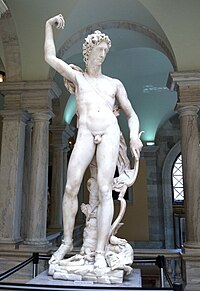
In classical times, his major function in popular religion was to keep away evil, and he was therefore called "apotropaios" (ἀποτρόπαιος, "averting evil") and "alexikakos" (ἀλεξίκακος "keeping off ill"; from v. ἀλέξω + n. κακόν).[66] Apollo also had many epithets relating to his function as a healer. Some commonly-used examples are "paion" (παιών literally "healer" or "helper")[67] "epikourios" (ἐπικούριος, "succouring"), "oulios" (οὔλιος, "healer, baleful")[68] and "loimios" (λοίμιος, "of the plague"). In later writers, the word, "paion", usually spelled "Paean", becomes a mere epithet of Apollo in his capacity as a god of healing.[69]
Apollo in his aspect of "healer" has a connection to the primitive god Paean (Παιών-Παιήων), who did not have a cult of his own. Paean serves as the healer of the gods in the Iliad, and seems to have originated in a pre-Greek religion.[70] It is suggested, though unconfirmed, that he is connected to the Mycenaean figure pa-ja-wo-ne (Linear B: 𐀞𐀊𐀺𐀚).[71][72][73] Paean was the personification of holy songs sung by "seer-doctors" (ἰατρομάντεις), which were supposed to cure disease.[74]
Homer uses the noun Paeon to designate both a god and that god's characteristic song of apotropaic thanksgiving and triumph.[75] Such songs were originally addressed to Apollo and afterwards to other gods: to Dionysus, to Apollo Helios, to Apollo's son Asclepius the healer. About the 4th century BCE, the paean became merely a formula of adulation; its object was either to implore protection against disease and misfortune or to offer thanks after such protection had been rendered. It was in this way that Apollo had become recognized as the god of music. Apollo's role as the slayer of the Python led to his association with battle and victory; hence it became the Roman custom for a paean to be sung by an army on the march and before entering into battle, when a fleet left the harbour, and also after a victory had been won.
In the Iliad, Apollo is the healer under the gods, but he is also the bringer of disease and death with his arrows, similar to the function of the Vedic god of disease Rudra.[76] He sends a plague (λοιμός) to the Achaeans. Knowing that Apollo can prevent a recurrence of the plague he sent, they purify themselves in a ritual and offer him a large sacrifice of cows, called a hecatomb.[77]
Dorian origin
The Homeric Hymn to Apollo depicts Apollo as an intruder from the north.[78] The connection with the northern-dwelling Dorians and their initiation festival apellai is reinforced by the month Apellaios in northwest Greek calendars.[79] The family-festival was dedicated to Apollo (Doric: Ἀπέλλων).[80] Apellaios is the month of these rites, and Apellon is the "megistos kouros" (the great Kouros).[81] However it can explain only the Doric type of the name, which is connected with the Ancient Macedonian word "pella" (Pella), stone. Stones played an important part in the cult of the god, especially in the oracular shrine of Delphi (Omphalos).[82][83]
Minoan origin

George Huxley considered the identification of Apollo with the Minoan deity Paiawon, worshipped in Crete, to have originated at Delphi.[84] In the Homeric Hymn, Apollo appears as a dolphin carrying Cretan priests to Delphi, to which site they evidently transfer their religious practices. Apollo Delphinios or Delphidios was a sea-god worshipped especially in Crete and in the islands.[85] Apollo's sister Artemis, who was the Greek goddess of hunting, is identified with Britomartis (Diktynna), the Minoan "Mistress of the animals". In her earliest depictions she was accompanied by the "Master of the animals", a bow-wielding god of hunting whose name has been lost; aspects of this figure may have been absorbed into the more popular Apollo.[86]
Anatolian origin
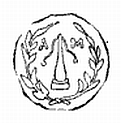
A non-Greek origin of Apollo has long been assumed in scholarship.[13] The name of Apollo's mother Leto has Lydian origin, and she was worshipped on the coasts of Asia Minor. The inspiration oracular cult was probably introduced into Greece from Anatolia, which is the origin of Sibyl, and where some of the oldest oracular shrines originated. Omens, symbols, purifications, and exorcisms appear in old Assyro-Babylonian texts. These rituals were spread into the empire of the Hittites, and from there into Greece.[87]
Homer pictures Apollo on the side of the Trojans, fighting against the Achaeans, during the Trojan War. He is pictured as a terrible god, less trusted by the Greeks than other gods. The god seems to be related to Appaliunas, a tutelary god of Wilusa (Troy) in Asia Minor, but the word is not complete.[88] The stones found in front of the gates of Homeric Troy were the symbols of Apollo. A western Anatolian origin may also be bolstered by references to the parallel worship of Artimus (Artemis) and Qλdãns, whose name may be cognate with the Hittite and Doric forms, in surviving Lydian texts.[89] However, recent scholars have cast doubt on the identification of Qλdãns with Apollo.[90]
The Greeks gave to him the name ἀγυιεύς agyieus as the protector god of public places and houses who wards off evil and his symbol was a tapered stone or column.[91] However, while usually Greek festivals were celebrated at the full moon, all the feasts of Apollo were celebrated on the seventh day of the month, and the emphasis given to that day (sibutu) indicates a Babylonian origin.[92]
Proto-Indo-European
The Vedic Rudra has some functions similar to those of Apollo. The terrible god is called "the archer" and the bow is also an attribute of Shiva.[93] Rudra could bring diseases with his arrows, but he was able to free people of them and his alternative Shiva is a healer physician god.[94] However the Indo-European component of Apollo does not explain his strong association with omens, exorcisms, and an oracular cult.
Oracular cult

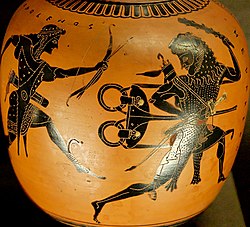
Unusually among the Olympic deities, Apollo had two cult sites that had widespread influence: Delos and Delphi. In cult practice, Delian Apollo and Pythian Apollo (the Apollo of Delphi) were so distinct that they might both have shrines in the same locality.[62] Lycia was sacred to the god, for this Apollo was also called Lycian.[95][96] Apollo's cult was already fully established when written sources commenced, about 650 BCE. Apollo became extremely important to the Greek world as an oracular deity in the archaic period, and the frequency of theophoric names such as Apollodorus or Apollonios and cities named Apollonia testify to his popularity. Oracular sanctuaries to Apollo were established in other sites. In the 2nd and 3rd century CE, those at Didyma and Claros pronounced the so-called "theological oracles", in which Apollo confirms that all deities are aspects or servants of an all-encompassing, highest deity. "In the 3rd century, Apollo fell silent. Julian the Apostate (359–361) tried to revive the Delphic oracle, but failed."[13]
Oracular shrines
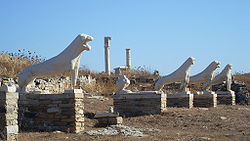
Apollo had a famous oracle in Delphi, and other notable ones in Claros and Didyma. His oracular shrine in Abae in Phocis, where he bore the toponymic epithet Abaeus (Ἀπόλλων Ἀβαῖος, Apollon Abaios), was important enough to be consulted by Croesus.[97] His oracular shrines include:
- Abae in Phocis.
- Bassae in the Peloponnese.
- At Clarus, on the west coast of Asia Minor; as at Delphi a holy spring which gave off a pneuma, from which the priests drank.
- In Corinth, the Oracle of Corinth came from the town of Tenea, from prisoners supposedly taken in the Trojan War.
- At Khyrse, in Troad, the temple was built for Apollo Smintheus.
- In Delos, there was an oracle to the Delian Apollo, during summer. The Hieron (Sanctuary) of Apollo adjacent to the Sacred Lake, was the place where the god was said to have been born.
- In Delphi, the Pythia became filled with the pneuma of Apollo, said to come from a spring inside the Adyton.
- In Didyma, an oracle on the coast of Anatolia, south west of Lydian (Luwian) Sardis, in which priests from the lineage of the Branchidae received inspiration by drinking from a healing spring located in the temple. Was believed to have been founded by Branchus, son or lover of Apollo.
- In Hierapolis Bambyce, Syria (modern Manbij), according to the treatise De Dea Syria, the sanctuary of the Syrian Goddess contained a robed and bearded image of Apollo. Divination was based on spontaneous movements of this image.[98]
- At Patara, in Lycia, there was a seasonal winter oracle of Apollo, said to have been the place where the god went from Delos. As at Delphi the oracle at Patara was a woman.
- In Segesta in Sicily.
Oracles were also given by sons of Apollo.
- In Oropus, north of Athens, the oracle Amphiaraus, was said to be the son of Apollo; Oropus also had a sacred spring.
- in Labadea, 20 miles (32 km) east of Delphi, Trophonius, another son of Apollo, killed his brother and fled to the cave where he was also afterwards consulted as an oracle.
Temples of Apollo
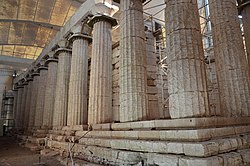
Many temples were dedicated to Apollo in Greece and the Greek colonies. They show the spread of the cult of Apollo and the evolution of Greek architecture, which was mostly based on the rightness of form and on mathematical relations. Some of the earliest temples, especially in Crete, do not belong to any Greek order. It seems that the first peripteral temples were rectangular wooden structures. The different wooden elements were considered divine, and their forms were preserved in the marble or stone elements of the temples of Doric order. The Greeks used standard types because they believed that the world of objects was a series of typical forms which could be represented in several instances. The temples should be canonic, and the architects were trying to achieve this esthetic perfection.[99] From the earliest times there were certain rules strictly observed in rectangular peripteral and prostyle buildings. The first buildings were built narrowly in order to hold the roof, and when the dimensions changed some mathematical relations became necessary in order to keep the original forms. This probably influenced the theory of numbers of Pythagoras, who believed that behind the appearance of things there was the permanent principle of mathematics.[100]
The Doric order dominated during the 6th and the 5th century BC but there was a mathematical problem regarding the position of the triglyphs, which could not be solved without changing the original forms. The order was almost abandoned for the Ionic order, but the Ionic capital also posed an insoluble problem at the corner of a temple. Both orders were abandoned for the Corinthian order gradually during the Hellenistic age and under Rome.
The most important temples are:
Greek temples

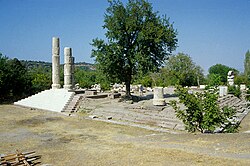
- Thebes, Greece: The oldest temple probably dedicated to Apollo Ismenius was built in the 9th century BC. It seems that it was a curvilinear building. The Doric temple was built in the early 7th century BC, but only some small parts have been found.[101] A festival called Daphnephoria was celebrated every ninth year in honour of Apollo Ismenius (or Galaxius). The people held laurel branches (daphnai), and at the head of the procession walked a youth (chosen priest of Apollo), who was called "daphnephoros".[102]
- Eretria: According to the Homeric hymn to Apollo, the god arrived on the plain, seeking for a location to establish its oracle. The first temple of Apollo Daphnephoros, "Apollo, laurel-bearer", or "carrying off Daphne", is dated to 800 BC. The temple was curvilinear hecatombedon (a hundred feet). In a smaller building were kept the bases of the laurel branches which were used for the first building. Another temple probably peripteral was built in the 7th century BC, with an inner row of wooden columns over its Geometric predecessor. It was rebuilt peripteral around 510 BC, with the stylobate measuring 21.00 x 43.00 m. The number of pteron column was 6 x 14.[103][104]
- Dreros (Crete). The temple of Apollo Delphinios dates from the 7th century BC, or probably from the middle of the 8th century BC. According to the legend, Apollo appeared as a dolphin, and carried Cretan priests to the port of Delphi.[105] The dimensions of the plan are 10.70 x 24.00 m and the building was not peripteral. It contains column-bases of the Minoan type, which may be considered as the predecessors of the Doric columns.[106]
- Gortyn (Crete). A temple of Pythian Apollo, was built in the 7th century BC. The plan measured 19.00 x 16.70 m and it was not peripteral. The walls were solid, made from limestone, and there was a single door on the east side.
- Thermon (West Greece): The Doric temple of Apollo Thermios, was built in the middle of the 7th century BC. It was built on an older curvilinear building dating perhaps from the 10th century, on which a peristyle was added. The temple was narrow, and the number of pteron columns (probably wooden) was 5 x 15. There was a single row of inner columns. It measures 12.13 x 38.23 m at the stylobate, which was made from stones.[107]

- Corinth: A Doric temple was built in the 6th century BC. The temple's stylobate measures 21.36 x 53.30 m, and the number of pteron columns was 6 x 15. There was a double row of inner columns. The style is similar to the Temple of Alcmeonidae at Delphi.[108] The Corinthians were considered to be the inventors of the Doric order.[107]
- Napes (Lesbos): An Aeolic temple probably of Apollo Napaios was built in the 7th century BC. Some special capitals with floral ornament have been found, which are called Aeolic, and it seems that they were borrowed from the East.[109]
- Cyrene, Libya: The oldest Doric temple of Apollo was built in c. 600 BC. The number of pteron columns was 6 x 11, and it measures 16.75 x 30.05 m at the stylobate. There was a double row of sixteen inner columns on stylobates. The capitals were made from stone.[109]
- Naukratis: An Ionic temple was built in the early 6th century BC. Only some fragments have been found and the earlier ones, made from limestone, are identified among the oldest of the Ionic order.[110]
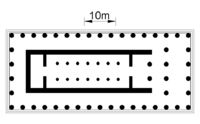
- Syracuse, Sicily: A Doric temple was built at the beginning of the 6th century BC. The temple's stylobate measures 21.47 x 55.36 m and the number of pteron columns was 6 x 17. It was the first temple in Greek west built completely out of stone. A second row of columns were added, obtaining the effect of an inner porch.[111]
- Selinus (Sicily):The Doric Temple C dates from 550 BC, and it was probably dedicated to Apollo. The temple's stylobate measures 10.48 x 41.63 m and the number of pteron columns was 6 x 17. There was a portico with a second row of columns, which is also attested for the temple at Syracuse.[112]
- Delphi: The first temple dedicated to Apollo, was built in the 7th century BC. According to the legend, it was wooden made of laurel branches. The "Temple of Alcmeonidae" was built in c. 513 BC and it is the oldest Doric temple with significant marble elements. The temple's stylobate measures 21.65 x 58.00 m, and the number of pteron columns as 6 x 15.[113] A fest similar with Apollo's fest at Thebes, Greece was celebrated every nine years. A boy was sent to the temple, who walked on the sacred road and returned carrying a laurel branch (dopnephoros). The maidens participated with joyful songs.[102]
- Chios: An Ionic temple of Apollo Phanaios was built at the end of the 6th century BC. Only some small parts have been found and the capitals had floral ornament.[109]
- Abae (Phocis). The temple was destroyed by the Persians in the invasion of Xerxes in 480 BC, and later by the Boeotians. It was rebuilt by Hadrian.[114] The oracle was in use from early Mycenaean times to the Roman period, and shows the continuity of Mycenaean and Classical Greek religion.[115]

- Bassae (Peloponnesus): A temple dedicated to Apollo Epikourios ("Apollo the helper"), was built in 430 BC, designed by Iktinos. It combined Doric and Ionic elements, and the earliest use of a column with a Corinthian capital in the middle.[116] The temple is of a relatively modest size, with the stylobate measuring 14.5 x 38.3 metres[117] containing a Doric peristyle of 6 x 15 columns. The roof left a central space open to admit light and air.
- Delos: A temple probably dedicated to Apollo and not peripteral, was built in the late 7th century BC, with a plan measuring 10.00 x 15.60 m. The Doric Great temple of Apollo, was built in c. 475 BC. The temple's stylobate measures 13.72 x 29.78 m, and the number of pteron columns as 6 x 13. Marble was extensively used.[109]
- Ambracia: A Doric peripteral temple dedicated to Apollo Pythios Sotir was built in 500 BC, at the centre of the Greek city Arta. Only some parts have been found, and it seems that the temple was built on earlier sanctuaries dedicated to Apollo. The temple measures 20.75 x 44.00 m at the stylobate. The foundation which supported the statue of the god, still exists.[118]

- Didyma (near Miletus): The gigantic Ionic temple of Apollo Didymaios started around 540 BC. The construction ceased and then it was restarted in 330 BC. The temple is dipteral, with an outer row of 10 x 21 columns, and it measures 28.90 x 80.75 m at the stylobate.[119]
- Clarus (near ancient Colophon): According to the legend, the famous seer Calchas, on his return from Troy, came to Clarus. He challenged the seer Mopsus, and died when he lost.[120] The Doric temple of Apollo Clarius was probably built in the 3rd century BC., and it was peripteral with 6 x 11 columns. It was reconstructed at the end of the Hellenistic period, and later from the emperor Hadrian but Pausanias claims that it was still incomplete in the 2nd century BC.[121]
- Hamaxitus (Troad): In the Iliad, Chryses the priest of Apollo, addresses the god with the epithet Smintheus (Lord of Mice), related to the god's ancient role as bringer of the disease (plague). Recent excavations indicate that the Hellenistic temple of Apollo Smintheus was constructed in 150–125 BC, but the symbol of the mouse god was used on coinage probably from the 4th century .[122] The temple measures 40.00 x 23.00 m at the stylobate, and the number of pteron columns was 8 x 14.[123]
- Pythion (Ancient Greek: Πύθιον), this was the name of a shrine of Apollo at Athens near the Ilisos river. It was created by Peisistratos, and tripods were placed there by those who had won in the cyclic chorus at the Thargelia.[124]
- Setae (Lydia): The temple of Apollo Aksyros located in the city.[125]
- Apollonia Pontica: There were two temples of Apollo Healer in the city. One from the Late Archaic period and the other from the Early Classical period.[126]
- Ikaros island in the Persian Gulf (modern Failaka Island): There was a temple of Apollo on the island.[127]
- Argos in Cyprus: there was a temple of Apollo Erithios (Ἐριθίου Ἀπόλλωνος ἱερῷ).[128]
- The temple and oracle of Apollo at Eutresis.[40]
- An altar of Apollo Acritas was at Lacedaemon. In addition, above a sanctuary surnamed Gasepton of Earth in Lacedaemon was set up the Maleatian Apollo.[129]
Etruscan and Roman temples
- Veii (Etruria): The temple of Apollo was built in the late 6th century BC, indicating the spread of Apollo's culture (Aplu) in Etruria. There was a prostyle porch, which is called Tuscan, and a triple cella 18.50 m wide.[130]
- Falerii Veteres (Etruria): A temple of Apollo was built probably in the 4th–3rd century BC. Parts of a terracotta capital, and a terracotta base have been found. It seems that the Etruscan columns were derived from the archaic Doric.[130] A cult of Apollo Soranus is attested by one inscription found near Falerii.[131]

- Pompeii (Italy): The cult of Apollo was widespread in the region of Campania since the 6th century BC. The temple was built in 120 BC, but its beginnings lie in the 6th century BC. It was reconstructed after an earthquake in AD 63. It demonstrates a mixing of styles which formed the basis of Roman architecture. The columns in front of the cella formed a Tuscan prostyle porch, and the cella is situated unusually far back. The peripteral colonnade of 48 Ionic columns was placed in such a way that the emphasis was given to the front side.[132]
- Rome: The temple of Apollo Sosianus and the temple of Apollo Medicus. The first temple building dates to 431 BC, and was dedicated to Apollo Medicus (the doctor), after a plague of 433 BC.[133] It was rebuilt by Gaius Sosius, probably in 34 BC. Only three columns with Corinthian capitals exist today. It seems that the cult of Apollo had existed in this area since at least to the mid-5th century BC.[134]
- Rome: The temple of Apollo Palatinus was located on the Palatine hill within the sacred boundary of the city. It was dedicated by Augustus in 28 BC. The façade of the original temple was Ionic and it was constructed from solid blocks of marble. Many famous statues by Greek masters were on display in and around the temple, including a marble statue of the god at the entrance and a statue of Apollo in the cella.[135]
- Melite (modern Mdina, Malta): A Temple of Apollo was built in the city in the 2nd century AD. Its remains were discovered in the 18th century, and many of its architectural fragments were dispersed among private collections or reworked into new sculptures. Parts of the temple's podium were rediscovered in 2002.[136]
Mythology
In the myths, Apollo is the son of Zeus, the king of the gods, and Leto, his previous wife[137] or one of his mistresses. Apollo often appears in the myths, plays and hymns either directly or indirectly through his oracles. As Zeus' favorite son, he had direct access to the mind of Zeus and was willing to reveal this knowledge to humans. A divinity beyond human comprehension, he appears both as a beneficial and a wrathful god.
Birth

Homeric Hymn to Apollo
Pregnant with the offsprings of Zeus, Leto wandered through many lands wanting to give birth to Apollo. However all the lands rejected her out of fear. Upon reaching Delos, Leto requested the island to shelter her, and that in return her son would bring fame and prosperity to the island. Delos then revealed to Leto that Apollo was rumoured to be the god who will "greatly lord it among gods and men all over the fruitful earth". For this reason, all the lands were fearful and Delos feared that Apollo would cast her aside once he is born. Hearing this, Leto swore on the river Styx that if she is allowed to give birth on the island, her son would honour Delos the most amongst all the other lands. Assured by this, Delos agreed to assist Leto. All goddesses except Hera also came to aid Leto.
However, Hera had tricked Eileithyia, the goddess of childbirth, to stay on Olympus, due to which Leto was unable to give birth. The goddesses then convinced Iris to go bring Eileithyia by offering her a necklace of amber 9 yards (8.2 m) long. Iris did accordingly and persuaded Eileithyia to step onto the island. Thus, clutching a palm tree, Leto finally gave birth after labouring for nine days and nine nights, with Apollo "leaping forth" from his mother's womb. The goddesses washed the newborn, covered him in a white garment and fastened golden bands around him. As Leto was unable to feed him, Themis, the goddess of divine law, fed him nectar and ambrosia. Upon tasting the divine food, the child broke free of the bands fastened onto him and declared that he would be the master of lyre and archery, and interpret the will of Zeus to humankind. He then started to walk, which caused the island to be filled with gold.[138]
Callimachus' hymn to Delos
The island Delos used to be Asteria, a goddess who jumped into the waters to escape the advances of Zeus and became a free-floating island of the same name. When Leto got pregnant, Hera was told that Leto's son would become more dear to Zeus than Ares. Enraged by this, Hera watched over the heavens and sent out Ares and Iris to prevent Leto from giving birth on the earth. Ares, stationed over the mainland, and Iris, over the islands, threatened all the lands and prevented them from helping Leto.
When Leto arrived at Thebes, fetal Apollo prophesied from his mother's womb that in the future he would punish a slanderous woman in Thebes (Niobe), so he did not want to be born there. Leto then went to Thessaly and sought the help of the river nymphs who were the daughters of the river Peneus. Though he was initially fearful and reluctant, Peneus later decided to let Leto give birth in his waters. He did not change his mind even when Ares produced a terrifying sound and threatened to hurl mountain peaks into the river. But Leto herself declined his help and departed, as she did not want him to suffer for her sake.
After being turned away from various lands, Apollo spoke again from the womb, asking his mother to take look at the floating island in front of her and expressing his wish to be born there. When Leto approached Asteria, all the other islands fled. But Asteria welcomed Leto without any fear of Hera. Walking on the island, she sat down against a palm tree and asked Apollo to be born. During the childbirth, swans circled the island seven times, a sign that later on Apollo would play the seven-stringed lyre. When Apollo finally "leapt forth" from his mother's womb, the nymphs of the island sang a hymn to Eileithyia that was heard to the heavens. The moment Apollo was born, the entire island, including the trees and the waters, became gold. Asteria bathed the newborn, swaddled him and fed him with her breast milk. The island had become rooted and was later called Delos.
Hera was no longer angry, as Zeus had managed to calm her down; and she held no grudge against Asteria, since Asteria had rejected Zeus in the past.[139]

Pindar's fragments
Pindar is the earliest source who explicitly calls Apollo and Artemis as twins. Here, Asteria is also stated to be Leto's sister. Wanting to escape Zeus' advances, she flung herself into the sea and became a floating rock called Ortygia until the twins were born.[140] When Leto stepped on the rock, four pillars with adamantine bases rose from the earth and held up the rock.[141] When Apollo and Artemis were born, their bodies shone radiantly and a chant was sung by Eileithyia and Lachesis, one of the three Moirai.[142]
Pseudo-Hyginus
Scorning the advances of Zeus, Asteria transformed herself into a bird and jumped into a sea. From her, an island rose which was called Ortygia.[143] When Hera discovered that Leto was pregnant with Zeus' child, she decreed that Leto can give birth only in a place where sun does not shine. During this time, the monster Python also started hounding Leto with an intent of killing her, because he had foreseen his death coming at the hands of Leto's offspring. However, on Zeus' orders, Boreas carried away Leto and entrusted her to Poseidon. To protect her, Poseidon took her to the island Ortygia and covered it with waves so that the sun would not shine on it. Leto gave birth clinging to an olive tree and henceforth the island was called Delos.[144]

Other variations of Apollo's birth include:
Aelian states that it took Leto twelve days and twelve nights to travel from Hyperborea to Delos.[145] Leto changed herself into a she-wolf before giving birth. This is given as the reason why Homer describes Apollo as the "wolf-born god".[146][147]
Libanius wrote that neither land nor visible islands would receive Leto, but by the will of Zeus Delos then became visible, and thus received Leto and the children.[148]
According to Strabo, the Curetes helped Leto by creating loud noises with their weapons and thus frightening Hera, they concealed Leto's childbirth.[149]
Theognis wrote that the island was filled with ambrosial fragrance when Apollo was born, and the Earth laughed with joy.[150]
In some versions, Artemis was born first and subsequently assisted with the birth of Apollo.[151][152]
While in some accounts Apollo's birth itself fixed the floating Delos to the earth, there are accounts of Apollo securing Delos to the bottom of the ocean a little while later.[153][154] This island became sacred to Apollo and was one of the major cult centres of the god. Apollo was born on the seventh day (ἑβδομαγενής, hebdomagenes)[155] of the month Thargelion—according to Delian tradition—or of the month Bysios—according to Delphian tradition. The seventh and twentieth, the days of the new and full moon, were ever afterwards held sacred to him.[21]
Hyperborea
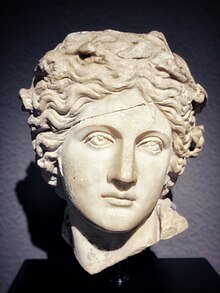
Hyperborea, the mystical land of eternal spring, venerated Apollo above all the gods. The Hyperboreans always sang and danced in his honor and hosted Pythian games.[156] There, a vast forest of beautiful trees was called "the garden of Apollo". Apollo spent the winter months among the Hyperboreans,[157][158] leaving his shrine in Delphi under the care of Dionysus. His absence from the world caused coldness and this was marked as his annual death. No prophecies were issued during this time.[159] He returned to the world during the beginning of the spring. The Theophania festival was held in Delphi to celebrate his return.[160]
However, Diodorus Silculus states that Apollo visited Hyperborea every nineteen years. This nineteen-year period was called by the Greeks as the 'year of Meton', the time period in which the stars returned to their initial positions. And that visiting Hyperborea at that time, Apollo played on the cithara and danced continuously from the vernal equinox until the rising of the Pleiades (constellations).[161]
Hyperborea was also Leto's birthplace. It is said that Leto came to Delos from Hyperborea accompanied by a pack of wolves. Henceforth, Hyperborea became Apollo's winter home and wolves became sacred to him. His intimate connection to wolves is evident from his epithet Lyceus, meaning wolf-like. But Apollo was also the wolf-slayer in his role as the god who protected flocks from predators. The Hyperborean worship of Apollo bears the strongest marks of Apollo being worshipped as the sun god. Shamanistic elements in Apollo's cult are often liked to his Hyperborean origin, and he is likewise speculated to have originated as a solar shaman.[162][163] Shamans like Abaris and Aristeas were also the followers of Apollo, who hailed from Hyperborea.
In myths, the tears of amber Apollo shed when his son Asclepius died mixed with the waters of the river Eridanos, which surrounded Hyperborea. Apollo also buried in Hyperborea the arrow which he had used to kill the Cyclopes. He later gave this arrow to Abaris.[164]
Childhood and youth
Growing up, Apollo was nursed by the nymphs Korythalia and Aletheia, the personification of truth.[165] Phoebe, his grandmother, gave the oracular shrine of Delphi to Apollo as a birthday gift.[166]
As a four-year-old child, Apollo built a foundation and an altar on Delos using the horns of the goats that his sister Artemis hunted. Since he learnt the art of building when young, he came to be known as Archegetes, (the founder of towns) and guided men to build new cities.[167] To keep the child amused, the Delian nymphs ran around the altar beating it, and then with their hands tied behind their backs, bit an olive branch. It later became a custom for all the sailors who passed by the island to do the same.[168]
From his father Zeus, Apollo received a golden headband and a chariot driven by swans.[169][170]
In his early years when Apollo spent his time herding cows, he was reared by the Thriae, who trained him and enhanced his prophetic skills.[171] The god Pan was also said to mentored him in the prophetic art.[172] Apollo is also said to have invented the lyre, and along with Artemis, the art of archery. He then taught the humans the art of healing and archery.[173]
Lycian peasants

Soon after giving birth to her twins, Leto fled from Delos fearing Hera. Upon reaching Lycia, her infants had drained all of their mother's milk and cried for more to satisfy their hunger. The exhausted mother then tried drinking from a nearby lake but was stopped by some Lycian peasants. When she begged them to let her quench her thirst, the haughty peasants not only threatened her but also stirred the mud in the lake to dirty the waters. Angered by this, Leto turned them into frogs.[174]
In a slightly varied version, Leto took her infants and crossed over to Lycia where she attempted to bathe her children in a spring she found there. But the local herdsmen drove her away. After that, some wolves found Leto and guided her to the river Xanthos, where Leto was able to bathe her children and quench her thirst. She then returned to the spring and turned the herdsmen into frogs.[175]
Slaying of Python
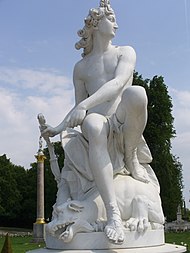
Python, a chthonic serpent-dragon, was a child of Gaia and the guardian of the Delphic Oracle. In the Callimachus' hymn to Delos, fetal Apollo foresees the death of Python at his hands.[168]
In the Homeric hymn to Apollo, Python was a female drakon and the nurse of the giant Typhon whom Hera had created to overthrow Zeus. She was described as a terrifying monster and a "bloody plague". Apollo, in his pursuit to establish his worship, came across Python and killed her with a single arrow shot from his bow. He let the corpse rot under the sun and declared himself the oracular deity of Delphi.[176] Other authors have Apollo kill the monster using a hundred arrows[177][178] or a thousand arrows.[179]

According to Euripides, Leto had brought her twins to the cliffs of Parnassus shortly after giving birth to them. Upon seeing the monster there, Apollo, still a child being carried in his mother's arms, leapt forth and killed Python.[180] Some authors also mention that Python was killed for displaying lustful affections towards Leto.[181][182]
In another account, Python chased pregnant Leto with an intent of killing her because his death was fated to come at the hands of Leto's child. However, he had to stop the chase when Leto came under the protection of Poseidon. After his birth, four days old Apollo killed the serpent with the bow and arrows gifted to him by Hephaestus and avenged the trouble given to his mother. The god then put the bones of the slain monster in a cauldron and deposited it in his temple.[183]
This legend is also narrated as the origin of the cry "Hië paian". According to Athenaeus, Python attacked Leto and her twins during their visit to Delphi. Taking Artemis into her arms, Leto climbed upon a rock and cried at Apollo to shoot the monster. The cry let out by her, "ιε, παῖ" ("Shoot, boy") later got slightly altered as "ἰὴ παιών" (Hië paian), an exclamation to avert evils.[184] Callimachus attributes the origin of this phrase to the Delphians, who let out the cry to encourage Apollo when the young god battled with Python.[185]
Strabo has recorded a slightly different version where Python was actually a cruel and lawless man who was also known by the name "Drakon". When Apollo was teaching the humans to cultivate fruits and civilise themselves, the residents of Parnassus complained to the god about Python. In response to their pleas, Apollo killed the man with his arrows. During the fight, the Parnassians shouted "Hië paian" to encourage the god.[186]
Establishment of worship in Delphi
Continuing from his victory over Python, the Homeric hymn describes how the young god established his worship among the humans. As Apollo was pondering about what kind of men he should recruit to serve him, he spotted a ship full of Cretan merchants or pirates. He took the form of a dolphin and sprang aboard the ship. Whenever the oblivious crew members tried throwing the dolphin overboard, the god shook the ship until the crew was awed into submission. Apollo then created a breeze that directed the ship to Delphi. Upon reaching the land, he revealed himself as a god and initiated them as his priests. He instructed them to guard his temple and always keep righteousness in their hearts.[187]
Alcaeus narrates the following account: Zeus, who had adorned his newborn son with a golden headband, also provided him with a chariot driven by swans and instructed Apollo to visit Delphi to establish his laws among the people. But Apollo disobeyed his father and went to the land of Hyperborea. The Delphians continuously sung paeans in his honour and pleaded him to come back to them. The god returned only after a year and then carried out Zeus' orders.[169][188]
In other variations, the shrine at Delphi was simply handed over to Apollo by his grandmother Phoebe as a gift,[166] or Themis herself inspired him to be the oracular voice of Delphi.[189]

However, in many other accounts, Apollo had to overcome certain obstacles before he was able to establish himself at Delphi. Gaea came in conflict with Apollo for killing Python and claiming the Delphic oracle for himself. According to Pindar, she sought to banish Apollo to Tartarus as a punishment.[190][191] According to Euripides, soon after Apollo took the ownership of the oracle, Gaea started sending prophetic dreams to the humans. As a result, people stopped visiting Delphi to obtain prophecies. Troubled by this, Apollo went to Olympus and supplicated to Zeus. Zeus, admiring the ambitions of his young son, granted his request by putting an end to the dream visions. This sealed the role of Apollo as the oracular deity of Delphi.[192]
Since Apollo had committed a blood crime, he also had to be purified. Pausanias has recorded two of the many variations of this purification. In one of them, both Apollo and Artemis fled to Sicyon and were purified there.[193] In the other tradition that had been prevalent among the Cretans, Apollo alone travelled to Crete and was purified by Carmanor.[194] In another account, the Argive king Crotopus was the one who performed the purification rites on Apollo alone.[195]
According the Aristonous and Aelian, Apollo was purified by the will of Zeus in the Vale of Tempe.[196] Aristonous has continued the tale, saying that Apollo was escorted back to Delphi by Athena. As a token of gratitude, he later built a temple for Athena at Delphi, which served as a threshold for his own temple.[197] Upon reaching Delphi, Apollo convinced Gaea and Themis into handing over the seat of oracle to him. To celebrate this event, other immortals also graced Apollo with gifts – Poseidon gave him the land of Delphi, the Delphian nymphs gifted him the Corycian cave, and Artemis set her dogs to patrol and safeguard the land.[198]
Some others have also said that Apollo was exiled and subjected to servitude under king Admetus as a means of punishment for the murder he had committed.[199] It was when he was serving as a cowherd under Admetus that the theft of the cattle by Hermes happened.[200][201] The servitude was said to have lasted for either one year,[202][203] or one great year (a cycle of eight years),[204][205] or nine years.[206]
Plutarch, however, has mentioned a variation where Apollo was neither purified in Tempe nor banished to Earth as a servant for nine years, but was driven out to another world for nine great years. The god who returned was cleansed and purified, thus becoming a "true Phoebus – that is to say, clear and bright". He then took over the Delphic oracle, which had been under the care of Themis in his absence.[207] Henceforth, Apollo became the god who cleansed himself from the sin of murder, made men aware of their guilt and purified them.[208]
The Pythian games were also established by Apollo, either as funeral games to honor Python[183][209] or to celebrate his own victory.[210][211][179] The Pythia was Apollo's high priestess and his mouthpiece through whom he gave prophecies.
Tityus
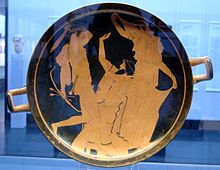
Tityus was another giant who tried to rape Leto, either on his own accord when she was on her way to Delphi[212][213] or at the order of Hera.[214] Leto called upon on her children who instantly slew the giant. Apollo, still a young boy, shot him with his arrows.[215][216] In some accounts, Artemis also joined him in protecting their mother by attacking Tityos with her arrows.[217][218] For this act, he was banished to Tartarus and there he was pegged to the rock floor and stretched on an area of 9 acres (36,000 m2), while a pair of vultures feasted daily on his liver[212] or his heart.[213]
Another account recorded by Strabo says that Tityus was not a giant but a lawless man whom Apollo killed at the request of the residents.[186]
Admetus

Admetus was the king of Pherae, who was known for his hospitality. When Apollo was exiled from Olympus for killing Python, he served as a herdsman under Admetus, who was then young and unmarried. Apollo is said to have shared a romantic relationship with Admetus during his stay.[158] After completing his years of servitude, Apollo went back to Olympus as a god.
Because Admetus had treated Apollo well, the god conferred great benefits on him in return. Apollo's mere presence is said to have made the cattle give birth to twins.[219][158] Apollo helped Admetus win the hand of Alcestis, the daughter of King Pelias,[220][221] by taming a lion and a boar to draw Admetus' chariot. He was present during their wedding to give his blessings. When Admetus angered the goddess Artemis by forgetting to give her the due offerings, Apollo came to the rescue and calmed his sister.[220] When Apollo learnt of Admetus' untimely death, he convinced or tricked the Fates into letting Admetus live past his time.[220][221]
According to another version, or perhaps some years later, when Zeus struck down Apollo's son Asclepius with a lightning bolt for resurrecting the dead, Apollo in revenge killed the Cyclopes, who had fashioned the bolt for Zeus.[219] Apollo would have been banished to Tartarus for this, but his mother Leto intervened, and reminding Zeus of their old love, pleaded with him not to kill their son. Zeus obliged and sentenced Apollo to one year of hard labor once again under Admetus.[219]
The love between Apollo and Admetus was a favored topic of Roman poets like Ovid and Servius.
Niobe
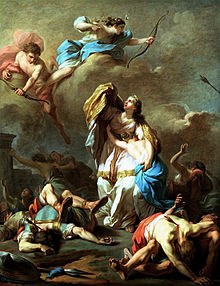
The fate of Niobe was prophesied by Apollo while he was still in Leto's womb.[158] Niobe was the queen of Thebes and wife of Amphion. She displayed hubris when she boasted that she was superior to Leto because she had fourteen children (Niobids), seven male and seven female, while Leto had only two. She further mocked Apollo's effeminate appearance and Artemis' manly appearance. Leto, insulted by this, told her children to punish Niobe. Accordingly, Apollo killed Niobe's sons, and Artemis her daughters. According to some versions of the myth, among the Niobids, Chloris and her brother Amyclas were not killed because they prayed to Leto. Amphion, at the sight of his dead sons, either killed himself or was killed by Apollo after swearing revenge.
A devastated Niobe fled to Mount Sipylos in Asia Minor and turned into stone as she wept. Her tears formed the river Achelous. Zeus had turned all the people of Thebes to stone and so no one buried the Niobids until the ninth day after their death, when the gods themselves entombed them.
When Chloris married and had children, Apollo granted her son Nestor the years he had taken away from the Niobids. Hence, Nestor was able to live for 3 generations.[222]
Building the walls of Troy

Once Apollo and Poseidon served under the Trojan king Laomedon in accordance with Zeus' words. Apollodorus states that the gods willingly went to the king disguised as humans in order to check his hubris.[223] Apollo guarded the cattle of Laomedon in the valleys of Mount Ida, while Poseidon built the walls of Troy.[224] Other versions make both Apollo and Poseidon the builders of the wall. In Ovid's account, Apollo completes his task by playing his tunes on his lyre.
In Pindar's odes, the gods took a mortal named Aeacus as their assistant.[225] When the work was completed, three snakes rushed against the wall, and though the two that attacked the sections of the wall built by the gods fell down dead, the third forced its way into the city through the portion of the wall built by Aeacus. Apollo immediately prophesied that Troy would fall at the hands of Aeacus's descendants, the Aeacidae (i.e. his son Telamon joined Heracles when he sieged the city during Laomedon's rule. Later, his great-grandson Neoptolemus was present in the wooden horse that leads to the downfall of Troy).
However, the king not only refused to give the gods the wages he had promised, but also threatened to bind their feet and hands, and sell them as slaves. Angered by the unpaid labour and the insults, Apollo infected the city with a pestilence and Poseidon sent the sea monster Cetus. To deliver the city from it, Laomedon had to sacrifice his daughter Hesione (who would later be saved by Heracles).
During his stay in Troy, Apollo had a lover named Ourea, who was a nymph and daughter of Poseidon. Together they had a son named Ileus, whom Apollo loved dearly.[226]
Trojan War
Apollo sided with the Trojans during the Trojan War waged by the Greeks against the Trojans.
During the war, the Greek king Agamemnon captured Chryseis, the daughter of Apollo's priest Chryses, and refused to return her. Angered by this, Apollo shot arrows infected with the plague into the Greek encampment. He demanded that they return the girl, and the Achaeans (Greeks) complied, indirectly causing the anger of Achilles, which is the theme of the Iliad.
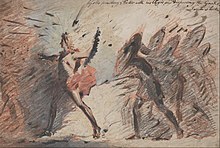
Receiving the aegis from Zeus, Apollo entered the battlefield as per his father's command, causing great terror to the enemy with his war cry. He pushed the Greeks back and destroyed many of the soldiers. He is described as "the rouser of armies" because he rallied the Trojan army when they were falling apart.
When Zeus allowed the other gods to get involved in the war, Apollo was provoked by Poseidon to a duel. However, Apollo declined to fight him, saying that he would not fight his uncle for the sake of mortals.

When the Greek hero Diomedes injured the Trojan hero Aeneas, Aphrodite tried to rescue him, but Diomedes injured her as well. Apollo then enveloped Aeneas in a cloud to protect him. He repelled the attacks Diomedes made on him and gave the hero a stern warning to abstain from attacking a god. Aeneas was then taken to Pergamos, a sacred spot in Troy, where he was healed.
After the death of Sarpedon, a son of Zeus, Apollo rescued the corpse from the battlefield as per his father's wish and cleaned it. He then gave it to Sleep (Hypnos) and Death (Thanatos). Apollo had also once convinced Athena to stop the war for that day, so that the warriors can relieve themselves for a while.

The Trojan hero Hector (who, according to some, was the god's own son by Hecuba[227]) was favored by Apollo. When he got severely injured, Apollo healed him and encouraged him to take up his arms. During a duel with Achilles, when Hector was about to lose, Apollo hid Hector in a cloud of mist to save him. When the Greek warrior Patroclus tried to get into the fort of Troy, he was stopped by Apollo. Encouraging Hector to attack Patroclus, Apollo stripped the armour of the Greek warrior and broke his weapons. Patroclus was eventually killed by Hector. At last, after Hector's fated death, Apollo protected his corpse from Achilles' attempt to mutilate it by creating a magical cloud over the corpse, shielding it from the rays of the sun.
Apollo held a grudge against Achilles throughout the war because Achilles had murdered his son Tenes before the war began and brutally assassinated his son Troilus in his own temple. Not only did Apollo save Hector from Achilles, he also tricked Achilles by disguising himself as a Trojan warrior and driving him away from the gates. He foiled Achilles' attempt to mutilate Hector's dead body.
Finally, Apollo caused Achilles' death by guiding an arrow shot by Paris into Achilles' heel. In some versions, Apollo himself killed Achilles by taking the disguise of Paris.
Apollo helped many Trojan warriors, including Agenor, Polydamas, Glaucus in the battlefield. Though he greatly favored the Trojans, Apollo was bound to follow the orders of Zeus and served his father loyally during the war.
Nurturer of the young
Apollo Kourotrophos is the god who nurtures and protects children and the young, especially boys. He oversees their education and their passage into adulthood. Education is said to have originated from Apollo and the Muses. Many myths have him train his children. It was a custom for boys to cut and dedicate their long hair to Apollo after reaching adulthood.
Chiron, the abandoned centaur, was fostered by Apollo, who instructed him in medicine, prophecy, archery and more. Chiron would later become a great teacher himself.
Asclepius in his childhood gained much knowledge pertaining to medicinal arts from his father. However, he was later entrusted to Chiron for further education.
Anius, Apollo's son by Rhoeo, was abandoned by his mother soon after his birth. Apollo brought him up and educated him in mantic arts. Anius later became the priest of Apollo and the king of Delos.
Iamus was the son of Apollo and Evadne. When Evadne went into labour, Apollo sent the Moirai to assist his lover. After the child was born, Apollo sent snakes to feed the child some honey. When Iamus reached the age of education, Apollo took him to Olympia and taught him many arts, including the ability to understand and explain the languages of birds.[228]
Idmon was educated by Apollo to be a seer. Even though he foresaw his death that would happen in his journey with the Argonauts, he embraced his destiny and died a brave death. To commemorate his son's bravery, Apollo commanded Boeotians to build a town around the tomb of the hero, and to honor him.[229]
Apollo adopted Carnus, the abandoned son of Zeus and Europa. He reared the child with the help of his mother Leto and educated him to be a seer.
When his son Melaneus reached the age of marriage, Apollo asked the princess Stratonice to be his son's bride and carried her away from her home when she agreed.
Apollo saved a shepherd boy (name unknown) from death in a large deep cave, by means of vultures. To thank him, the shepherd built Apollo a temple under the name Vulturius.[230]
God of music
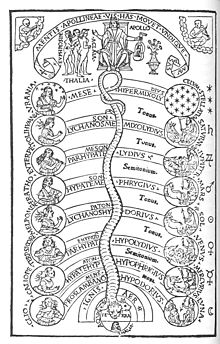

Immediately after his birth, Apollo demanded a lyre and invented the paean, thus becoming the god of music. As the divine singer, he is the patron of poets, singers and musicians. The invention of string music is attributed to him. Plato said that the innate ability of humans to take delight in music, rhythm and harmony is the gift of Apollo and the Muses.[231] According to Socrates, ancient Greeks believed that Apollo is the god who directs the harmony and makes all things move together, both for the gods and the humans. For this reason, he was called Homopolon before the Homo was replaced by A.[232][233] Apollo's harmonious music delivered people from their pain, and hence, like Dionysus, he is also called the liberator.[158] The swans, which were considered to be the most musical among the birds, were believed to be the "singers of Apollo". They are Apollo's sacred birds and acted as his vehicle during his travel to Hyperborea.[158] Aelian says that when the singers would sing hymns to Apollo, the swans would join the chant in unison.[234]
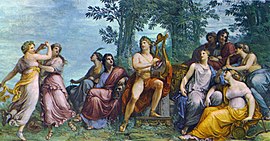
Among the Pythagoreans, the study of mathematics and music were connected to the worship of Apollo, their principal deity.[235][236][237] Their belief was that music purifies the soul, just as medicine purifies the body. They also believed that music was delegated to the same mathematical laws of harmony as the mechanics of the cosmos, evolving into an idea known as the music of the spheres.[238]
Apollo appears as the companion of the Muses, and as Musagetes ("leader of Muses") he leads them in dance. They spend their time on Parnassus, which is one of their sacred places. Apollo is also the lover of the Muses and by them he became the father of famous musicians like Orpheus and Linus.
Apollo is often found delighting the immortal gods with his songs and music on the lyre.[239] In his role as the god of banquets, he was always present to play music at weddings of the gods, like the marriage of Eros and Psyche, Peleus and Thetis. He is a frequent guest of the Bacchanalia, and many ancient ceramics depict him being at ease amidst the maenads and satyrs.[240] Apollo also participated in musical contests when challenged by others. He was the victor in all those contests, but he tended to punish his opponents severely for their hubris.

Apollo's lyre
The invention of the lyre is attributed either to Hermes or to Apollo himself.[241] Distinctions have been made that Hermes invented lyre made of tortoise shell, whereas the lyre Apollo invented was a regular lyre.[242]
Myths tell that the infant Hermes stole a number of Apollo's cows and took them to a cave in the woods near Pylos, covering their tracks. In the cave, he found a tortoise and killed it, then removed the insides. He used one of the cow's intestines and the tortoise shell and made his lyre.

Upon discovering the theft, Apollo confronted Hermes and asked him to return his cattle. When Hermes acted innocent, Apollo took the matter to Zeus. Zeus, having seen the events, sided with Apollo, and ordered Hermes to return the cattle.[243] Hermes then began to play music on the lyre he had invented. Apollo fell in love with the instrument and offered to exchange the cattle for the lyre. Hence, Apollo then became the master of the lyre.
According to other versions, Apollo had invented the lyre himself, whose strings he tore in repenting of the excess punishment he had given to Marsyas. Hermes' lyre, therefore, would be a reinvention.[244]
Contest with Pan
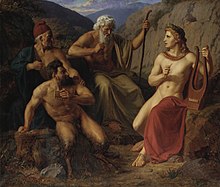
Once Pan had the audacity to compare his music with that of Apollo and to challenge the god of music to a contest. The mountain-god Tmolus was chosen to umpire. Pan blew on his pipes, and with his rustic melody gave great satisfaction to himself and his faithful follower, Midas, who happened to be present. Then, Apollo struck the strings of his lyre. It was so beautiful that Tmolus at once awarded the victory to Apollo, and everyone was pleased with the judgement. Only Midas dissented and questioned the justice of the award. Apollo did not want to suffer such a depraved pair of ears any longer, and caused them to become the ears of a donkey.
Contest with Marsyas
Marsyas was a satyr who was punished by Apollo for his hubris. He had found an aulos on the ground, tossed away after being invented by Athena because it made her cheeks puffy. Athena had also placed a curse upon the instrument, that whoever would pick it up would be severely punished. When Marsyas played the flute, everyone became frenzied with joy. This led Marsyas to think that he was better than Apollo, and he challenged the god to a musical contest. The contest was judged by the Muses, or the nymphs of Nysa. Athena was also present to witness the contest.
Marsyas taunted Apollo for "wearing his hair long, for having a fair face and smooth body, for his skill in so many arts".[245] He also further said,
'His [Apollo] hair is smooth and made into tufts and curls that fall about his brow and hang before his face. His body is fair from head to foot, his limbs shine bright, his tongue gives oracles, and he is equally eloquent in prose or verse, propose which you will. What of his robes so fine in texture, so soft to the touch, aglow with purple? What of his lyre that flashes gold, gleams white with ivory, and shimmers with rainbow gems? What of his song, so cunning and so sweet? Nay, all these allurements suit with naught save luxury. To virtue they bring shame alone!'[245]
The Muses and Athena sniggered at this comment. The contestants agreed to take turns displaying their skills and the rule was that the victor could "do whatever he wanted" to the loser.
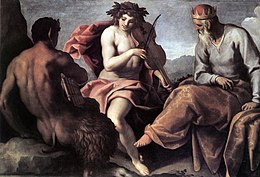
According to one account, after the first round, they both were deemed equal by the Nysiads. But in the next round, Apollo decided to play on his lyre and add his melodious voice to his performance. Marsyas argued against this, saying that Apollo would have an advantage and accused Apollo of cheating. But Apollo replied that since Marsyas played the flute, which needed air blown from the throat, it was similar to singing, and that either they both should get an equal chance to combine their skills or none of them should use their mouths at all. The nymphs decided that Apollo's argument was just. Apollo then played his lyre and sang at the same time, mesmerising the audience. Marsyas could not do this. Apollo was declared the winner and, angered with Marsyas' haughtiness and his accusations, decided to flay the satyr.[246]

According to another account, Marsyas played his flute out of tune at one point and accepted his defeat. Out of shame, he assigned to himself the punishment of being skinned for a wine sack.[247] Another variation is that Apollo played his instrument upside down. Marsyas could not do this with his instrument. So the Muses who were the judges declared Apollo the winner. Apollo hung Marsyas from a tree to flay him.[248]
Apollo flayed the limbs of Marsyas alive in a cave near Celaenae in Phrygia for his hubris to challenge a god. He then gave the rest of his body for proper burial[249] and nailed Marsyas' flayed skin to a nearby pine-tree as a lesson to the others. Marsyas' blood turned into the river Marsyas. But Apollo soon repented and being distressed at what he had done, he tore the strings of his lyre and threw it away. The lyre was later discovered by the Muses and Apollo's sons Linus and Orpheus. The Muses fixed the middle string, Linus the string struck with the forefinger, and Orpheus the lowest string and the one next to it. They took it back to Apollo, but the god, who had decided to stay away from music for a while, laid away both the lyre and the pipes at Delphi and joined Cybele in her wanderings to as far as Hyperborea.[246][250]
Contest with Cinyras
Cinyras was a ruler of Cyprus, who was a friend of Agamemnon. Cinyras promised to assist Agamemnon in the Trojan war, but did not keep his promise. Agamemnon cursed Cinyras. He invoked Apollo and asked the god to avenge the broken promise. Apollo then had a lyre-playing contest with Cinyras, and defeated him. Either Cinyras committed suicide when he lost, or was killed by Apollo.[251][252]

Patron of sailors
Apollo functions as the patron and protector of sailors, one of the duties he shares with Poseidon. In the myths, he is seen helping heroes who pray to him for a safe journey.
When Apollo spotted a ship of Cretan sailors that were caught in a storm, he quickly assumed the shape of a dolphin and guided their ship safely to Delphi.[253]
When the Argonauts faced a terrible storm, Jason prayed to his patron, Apollo, to help them. Apollo used his bow and golden arrow to shed light upon an island, where the Argonauts soon took shelter. This island was renamed "Anaphe", which means "He revealed it".[254]
Apollo helped the Greek hero Diomedes, to escape from a great tempest during his journey homeward. As a token of gratitude, Diomedes built a temple in honor of Apollo under the epithet Epibaterius ("the embarker").[255]
During the Trojan War, Odysseus came to the Trojan camp to return Chriseis, the daughter of Apollo's priest Chryses, and brought many offerings to Apollo. Pleased with this, Apollo sent gentle breezes that helped Odysseus return safely to the Greek camp.[256]
Arion was a poet who was kidnapped by some sailors for the rich prizes he possessed. Arion requested them to let him sing for the last time, to which the sailors consented. Arion began singing a song in praise of Apollo, seeking the god's help. Consequently, numerous dolphins surrounded the ship and when Arion jumped into the water, the dolphins carried him away safely.
Wars
Trojan War
Apollo played a pivotal role in the entire Trojan War. He sided with the Trojans, and sent a terrible plague to the Greek camp, which indirectly led to the conflict between Achilles and Agamemnon. He killed the Greek heroes Patroclus, Achilles, and numerous Greek soldiers. He also helped many Trojan heroes, the most important one being Hector. After the end of the war, Apollo and Poseidon together cleaned the remains of the city and the camps.
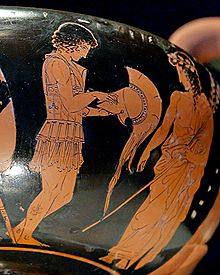
Telegony war
A war broke out between the Brygoi and the Thesprotians, who had the support of Odysseus. The gods Athena and Ares came to the battlefield and took sides. Athena helped the hero Odysseus while Ares fought alongside of the Brygoi. When Odysseus lost, Athena and Ares came into a direct duel. To stop the battling gods and the terror created by their battle, Apollo intervened and stopped the duel between them.[257][258]
Indian war
When Zeus suggested that Dionysus defeat the Indians in order to earn a place among the gods, Dionysus declared war against the Indians and travelled to India along with his army of Bacchantes and satyrs. Among the warriors was Aristaeus, Apollo's son. Apollo armed his son with his own hands and gave him a bow and arrows and fitted a strong shield to his arm.[259] After Zeus urged Apollo to join the war, he went to the battlefield.[260] Seeing several of his nymphs and Aristaeus drowning in a river, he took them to safety and healed them.[261] He taught Aristaeus more useful healing arts and sent him back to help the army of Dionysus.
Theban war
During the war between the sons of Oedipus, Apollo favored Amphiaraus, a seer and one of the leaders in the war. Though saddened that the seer was fated to be doomed in the war, Apollo made Amphiaraus' last hours glorious by "lighting his shield and his helm with starry gleam". When Hypseus tried to kill the hero with a spear, Apollo directed the spear towards the charioteer of Amphiaraus instead. Then Apollo himself replaced the charioteer and took the reins in his hands. He deflected many spears and arrows away from them. He also killed many of the enemy warriors like Melaneus, Antiphus, Aetion, Polites and Lampus. At last, when the moment of departure came, Apollo expressed his grief with tears in his eyes and bid farewell to Amphiaraus, who was soon engulfed by the Earth.[262]
Slaying of giants
Apollo killed the giants Python and Tityos, who had assaulted his mother Leto.
Gigantomachy
During the gigantomachy, Apollo and Heracles blinded the giant Ephialtes by shooting him in his eyes, Apollo shooting his left and Heracles his right.[263] He also killed Porphyrion, the king of giants, using his bow and arrows.[264]
Aloadae
The Aloadae, namely Otis and Ephialtes, were twin giants who decided to wage war upon the gods. They attempted to storm Mt. Olympus by piling up mountains, and threatened to fill the sea with mountains and inundate dry land.[265] They even dared to seek the hand of Hera and Artemis in marriage. Angered by this, Apollo killed them by shooting them with arrows.[266] According to another tale, Apollo killed them by sending a deer between them; as they tried to kill it with their javelins, they accidentally stabbed each other and died.[267]
Phorbas
Phorbas was a savage giant king of Phlegyas who was described as having swine-like features. He wished to plunder Delphi for its wealth. He seized the roads to Delphi and started harassing the pilgrims. He captured the old people and children and sent them to his army to hold them for ransom. And he challenged the young and sturdy men to a match of boxing, only to cut their heads off when they would get defeated by him. He hung the chopped-off heads to an oak tree. Finally, Apollo came to put an end to this cruelty. He entered a boxing contest with Phorbas and killed him with a single blow.[268]
Other stories

In the first Olympic games, Apollo defeated Ares and became the victor in wrestling. He outran Hermes in the race and won first place.[269]
Apollo divides months into summer and winter.[270] He rides on the back of a swan to the land of the Hyperboreans during the winter months, and the absence of warmth in winter is due to his departure. During his absence, Delphi was under the care of Dionysus, and no prophecies were given during winters.
Periphas
Periphas was an Attican king and a priest of Apollo. He was noble, just and rich. He did all his duties justly. Because of this people were very fond of him and started honouring him to the same extent as Zeus. At one point, they worshipped Periphas in place of Zeus and set up shrines and temples for him. This annoyed Zeus, who decided to annihilate the entire family of Periphas. But because he was a just king and a good devotee, Apollo intervened and requested his father to spare Periphas. Zeus considered Apollo's words and agreed to let him live. But he metamorphosed Periphas into an eagle and made the eagle the king of birds. When Periphas' wife requested Zeus to let her stay with her husband, Zeus turned her into a vulture and fulfilled her wish.[271]
Molpadia and Parthenos
Molpadia and Parthenos were the sisters of Rhoeo, a former lover of Apollo. One day, they were put in charge of watching their father's ancestral wine jar but they fell asleep while performing this duty. While they were asleep, the wine jar was broken by the swine their family kept. When the sisters woke up and saw what had happened, they threw themselves off a cliff in fear of their father's wrath. Apollo, who was passing by, caught them and carried them to two different cities in Chersonesus, Molpadia to Castabus and Parthenos to Bubastus. He turned them into goddesses and they both received divine honors. Molpadia's name was changed to Hemithea upon her deification.[272]
Prometheus
Prometheus was the titan who was punished by Zeus for stealing fire. He was bound to a rock, where each day an eagle was sent to eat Prometheus' liver, which would then grow back overnight to be eaten again the next day. Seeing his plight, Apollo pleaded with Zeus to release the kind Titan, while Artemis and Leto stood behind him with tears in their eyes. Zeus, moved by Apollo's words and the tears of the goddesses, finally sent Heracles to free Prometheus.[273]

Heracles
After Heracles (then named Alcides) was struck with madness and killed his family, he sought to purify himself and consulted the oracle of Apollo. Apollo, through the Pythia, commanded him to serve king Eurystheus for twelve years and complete the ten tasks the king would give him. Only then would Alcides be absolved of his sin. Apollo also renamed him Heracles.[274]

To complete his third task, Heracles had to capture the Ceryneian Hind, a hind sacred to Artemis, and bring back it alive. After chasing the hind for one year, the animal eventually got tired, and when it tried crossing the river Ladon, Heracles captured it. While he was taking it back, he was confronted by Apollo and Artemis, who were angered at Heracles for this act. However, Heracles soothed the goddess and explained his situation to her. After much pleading, Artemis permitted him to take the hind and told him to return it later.[275]
After he was freed from his servitude to Eurystheus, Heracles fell in conflict with Iphytus, a prince of Oechalia, and murdered him. Soon after, he contracted a terrible disease. He consulted the oracle of Apollo once again, in the hope of ridding himself of the disease. The Pythia, however, denied to give any prophesy. In anger, Heracles snatched the sacred tripod and started walking away, intending to start his own oracle. However, Apollo did not tolerate this and stopped Heracles; a duel ensued between them. Artemis rushed to support Apollo, while Athena supported Heracles. Soon, Zeus threw his thunderbolt between the fighting brothers and separated them. He reprimanded Heracles for this act of violation and asked Apollo to give a solution to Heracles. Apollo then ordered the hero to serve under Omphale, queen of Lydia for one year in order to purify himself.
After their reconciliation, Apollo and Heracles together founded the city of Gythion.[276]
Plato's concept of soulmates
A long time ago, there were three kinds of human beings: male, descended from the sun; female, descended from the earth; and androgynous, descended from the moon. Each human being was completely round, with four arms and four legs, two identical faces on opposite sides of a head with four ears, and all else to match. They were powerful and unruly. Otis and Ephialtes even dared to scale Mount Olympus.
To check their insolence, Zeus devised a plan to humble them and improve their manners instead of completely destroying them. He cut them all in two and asked Apollo to make necessary repairs, giving humans the individual shape they still have now. Apollo turned their heads and necks around towards their wounds, he pulled together their skin at the abdomen, and sewed the skin together at the middle of it. This is what we call navel today. He smoothened the wrinkles and shaped the chest. But he made sure to leave a few wrinkles on the abdomen and around the navel so that they might be reminded of their punishment.[277]
"As he [Zeus] cut them one after another, he bade Apollo give the face and the half of the neck a turn... Apollo was also bidden to heal their wounds and compose their forms. So Apollo gave a turn to the face and pulled the skin from the sides all over that which in our language is called the belly, like the purses which draw in, and he made one mouth at the centre [of the belly] which he fastened in a knot (the same which is called the navel); he also moulded the breast and took out most of the wrinkles, much as a shoemaker might smooth leather upon a last; he left a few wrinkles, however, in the region of the belly and navel, as a memorial of the primeval state.
The rock of Leukas
Leukatas was believed to be a white-colored rock jutting out from the island of Leukas into the sea. It was present in the sanctuary of Apollo Leukates. A leap from this rock was believed to have put an end to the longings of love.[278]
Once, Aphrodite fell deeply in love with Adonis, a young man of great beauty who was later accidentally killed by a boar. Heartbroken, Aphrodite wandered looking for the rock of Leukas. When she reached the sanctuary of Apollo in Argos, she confided in him her love and sorrow. Apollo then brought her to the rock of Leukas and asked her to throw herself from the top of the rock. She did so and was freed from her love. When she sought the reason behind this, Apollo told her that Zeus, before taking another lover, would sit on this rock to free himself from his love for Hera.[209]
Another tale relates that a man named Nireus, who fell in love with the cult statue of Athena, came to the rock and jumped in order to relieve himself. After jumping, he fell into the net of a fisherman in which, when he was pulled out, he found a box filled with gold. He fought with the fisherman and took the gold, but Apollo appeared to him in the night in a dream and warned him not to appropriate gold which belonged to others.[209]
It was an ancestral custom among the Leukadians to fling a criminal from this rock every year at the sacrifice performed in honor of Apollo for the sake of averting evil. However, a number of men would be stationed all around below rock to catch the criminal and take him out of the borders in order to exile him from the island.[279][209] This was the same rock from which, according to a legend, Sappho took her suicidal leap.[278]
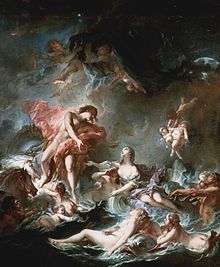
Slaying of Titans
Once Hera, out of spite, aroused the Titans to war against Zeus and take away his throne. Accordingly, when the Titans tried to climb Mount Olympus, Zeus with the help of Apollo, Artemis and Athena, defeated them and cast them into Tartarus.[280]
Female lovers

Apollo is said to have been the lover of all nine Muses, and not being able to choose one of them, he decided to remain unwed. He fathered the Corybantes by the Muse Thalia.[281] By Calliope, he had Hymenaios, Ialemus, Orpheus[282] and Linus. Alternatively, Linus was said to be the son of Apollo and either Urania or Terpsichore.
In the Great Eoiae that is attributed to Hesoid, Scylla is the daughter of Apollo and Hecate.[283]
Cyrene was a Thessalian princess whom Apollo loved. In her honor, he built the city Cyrene and made her its ruler. She was later granted longevity by Apollo who turned her into a nymph. The couple had two sons, Aristaeus, and Idmon.
Evadne was a nymph daughter of Poseidon and a lover of Apollo. They had a son, Iamos. During the time of the childbirth, Apollo sent Eileithyia, the goddess of childbirth to assist her.
Rhoeo, a princess of the island of Naxos was loved by Apollo. Out of affection for her, Apollo turned her sisters into goddesses. On the island Delos she bore Apollo a son named Anius. Not wanting to have the child, she entrusted the infant to Apollo and left. Apollo raised and educated the child on his own.
Ourea, a daughter of Poseidon, fell in love with Apollo when he and Poseidon were serving the Trojan king Laomedon. They both united on the day the walls of Troy were built. She bore to Apollo a son, whom Apollo named Ileus, after the city of his birth, Ilion (Troy). Ileus was very dear to Apollo.[284]
Thero, daughter of Phylas, a maiden as beautiful as the moonbeams, was loved by the radiant Apollo, and she loved him in return. Through their union, she became the mother of Chaeron, who was famed as "the tamer of horses". He later built the city Chaeronea.[285]
Hyrie or Thyrie was the mother of Cycnus. Apollo turned both the mother and son into swans when they jumped into a lake and tried to kill themselves.[286]
Hecuba was the wife of King Priam of Troy, and Apollo had a son with her named Troilus. An oracle prophesied that Troy would not be defeated as long as Troilus reached the age of twenty alive. He was ambushed and killed by Achilleus, and Apollo avenged his death by killing Achilles. After the sack of Troy, Hecuba was taken to Lycia by Apollo.[287]
Coronis was daughter of Phlegyas, King of the Lapiths. While pregnant with Asclepius, Coronis fell in love with Ischys, son of Elatus and slept with him. When Apollo found out about her infidelity through his prophetic powers or thanks to his raven who informed him, he sent his sister, Artemis, to kill Coronis. Apollo rescued the baby by cutting open Coronis' belly and gave it to the centaur Chiron to raise.
Dryope, the daughter of Dryops, was impregnated by Apollo in the form of a snake. She gave birth to a son named Amphissus.[288]
In Euripides' play Ion, Apollo fathered Ion by Creusa, wife of Xuthus. He used his powers to conceal her pregnancy from her father. Later, when Creusa left Ion to die in the wild, Apollo asked Hermes to save the child and bring him to the oracle at Delphi, where he was raised by a priestess.
Apollo loved and kidnapped an Oceanid nymph, Melia. Her father Oceanus sent one of his sons, Caanthus, to find her, but Caanthus could not take her back from Apollo, so he burned Apollo's sanctuary. In retaliation, Apollo shot and killed Caanthus.[289]
Male lovers


Hyacinth (or Hyacinthus), a beautiful and athletic Spartan prince, was one of Apollo's favourite lovers.[290] The pair was practicing throwing the discus when a discus thrown by Apollo was blown off course by the jealous Zephyrus and struck Hyacinthus in the head, killing him instantly. Apollo is said to be filled with grief. Out of Hyacinthus' blood, Apollo created a flower named after him as a memorial to his death, and his tears stained the flower petals with the interjection αἰαῖ, meaning alas.[291] He was later resurrected and taken to heaven. The festival Hyacinthia was a national celebration of Sparta, which commemorated the death and rebirth of Hyacinthus.[292]
Another male lover was Cyparissus, a descendant of Heracles. Apollo gave him a tame deer as a companion but Cyparissus accidentally killed it with a javelin as it lay asleep in the undergrowth. Cyparissus was so saddened by its death that he asked Apollo to let his tears fall forever. Apollo granted the request by turning him into the Cypress named after him, which was said to be a sad tree because the sap forms droplets like tears on the trunk.[293]

Admetus, the king of Pherae, was also Apollo's lover.[294][295] During his exile, which lasted either for one year or nine years,[296] Apollo served Admetus as a herdsman. The romantic nature of their relationship was first described by Callimachus of Alexandria, who wrote that Apollo was "fired with love" for Admetus.[158] Plutarch lists Admetus as one of Apollo's lovers and says that Apollo served Admetus because he doted upon him.[297] Latin poet Ovid in his Ars Amatoria said that even though he was a god, Apollo forsook his pride and stayed in as a servant for the sake of Admetus.[298] Tibullus describes Apollo's love to the king as servitium amoris (slavery of love) and asserts that Apollo became his servant not by force but by choice. He would also make cheese and serve it to Admetus. His domestic actions caused embarrassment to his family.[299]

Oh how often his sister (Diana) blushed at meeting her brother as he carried a young calf through the fields!....often Latona lamented when she saw her son's disheveled locks which were admired even by Juno, his step-mother...[300]
When Admetus wanted to marry princess Alcestis, Apollo provided a chariot pulled by a lion and a boar he had tamed. This satisfied Alcestis' father and he let Admetus marry his daughter. Further, Apollo saved the king from Artemis' wrath and also convinced the Moirai to postpone Admetus' death once.
Branchus, a shepherd, one day came across Apollo in the woods. Captivated by the god's beauty, he kissed Apollo. Apollo requited his affections and wanting to reward him, bestowed prophetic skills on him. His descendants, the Branchides, were an influential clan of prophets.[301]
Other male lovers of Apollo include:
- Adonis, who is said to have been the lover of both Apollo and Aphrodite. He behaved as a man with Aphrodite and as a woman with Apollo.[302]
- Atymnius,[303] otherwise known as a beloved of Sarpedon
- Boreas, the god of North winds[304]
- Cinyras, king of Cyprus and the priest of Aphrodite[305]
- Helenus, a Trojan prince (son of Priam and Hecuba). He received from Apollo an ivory bow with which he later wounded Achilles in the hand.[306]
- Hippolytus of Sicyon (not the same as Hippolytus, the son of Theseus)[295]
- Hymenaios, the son of Magnes[307]
- Iapis, to whom Apollo taught the art of healing[308]
- Phorbas, the dragon slayer (probably the son of Triopas)[309]
Children
Apollo sired many children, from mortal women and nymphs as well as the goddesses. His children grew up to be physicians, musicians, poets, seers or archers. Many of his sons founded new cities and became kings.
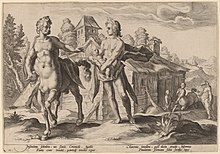
Asclepius is the most famous son of Apollo. His skills as a physician surpassed that of Apollo's. Zeus killed him for bringing back the dead, but upon Apollo's request, he was resurrected as a god. Aristaeus was placed under the care of Chiron after his birth. He became the god of beekeeping, cheese-making, animal husbandry and more. He was ultimately given immortality for the benefits he bestowed upon humanity. The Corybantes were spear-clashing, dancing demigods.
The sons of Apollo who participated in the Trojan War include the Trojan princes Hector and Troilus, as well as Tenes, the king of Tenedos, all three of whom were killed by Achilles over the course of the war.
Apollo's children who became musicians and bards include Orpheus, Linus, Ialemus, Hymenaeus, Philammon, Eumolpus and Eleuther. Apollo fathered 3 daughters, Apollonis, Borysthenis and Cephisso, who formed a group of minor Muses, the "Musa Apollonides".[310] Plutarch recounts that the Delphians believed the three Muses to be Nete, Mese, and Hypate, after the highest, middle, and lowest strings of the lyre.[311] Phemonoe was a seer and poet who was the inventor of Hexameter.
Apis, Idmon, Iamus, Tenerus, Mopsus, Galeus, Telmessus and others were gifted seers. Anius, Pythaeus and Ismenus lived as high priests. Most of them were trained by Apollo himself.
Arabus, Delphos, Dryops, Miletos, Tenes, Epidaurus, Ceos, Lycoras, Syrus, Pisus, Marathus, Megarus, Patarus, Acraepheus, Cicon, Chaeron and many other sons of Apollo, under the guidance of his words, founded eponymous cities.
He also had a son by Agathippe who was named Chrysorrhoas who was a mechanic artist.[312] His other daughters include Eurynome, Chariclo wife of Chiron, Eurydice the wife of Orpheus, Eriopis, famous for her beautiful hair, Melite the heroine, Pamphile the silk weaver, Parthenos, and by some accounts, Phoebe, Hilyra and Scylla. Apollo turned Parthenos into a constellation after her early death.
Additionally, Apollo fostered and educated Chiron, the centaur who later became the greatest teacher and educated many demigods, including Apollo's sons. Apollo also fostered Carnus, the son of Zeus and Europa.
List of offspring and their mothers
The following is a list of Apollo's offspring, by various mothers. Beside each offspring, the earliest source to record the parentage is given, along with the century to which the source (in some cases approximately) dates.
Failed love attempts
Love affairs ascribed to Apollo are a late development in Greek mythology.[388] Their vivid anecdotal qualities have made some of them favorites of painters since the Renaissance, the result being that they stand out more prominently in the modern imagination.
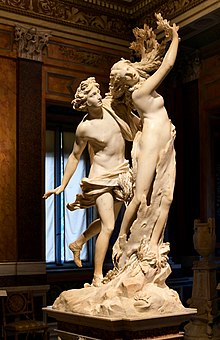
Daphne was a nymph who scorned Apollo's advances and ran away from him. When Apollo chased her in order to persuade her, she changed herself into a laurel tree. According to other versions, she cried for help during the chase, and Gaia helped her by taking her in and placing a laurel tree in her place.[389] According to Roman poet Ovid, the chase was brought about by Cupid, who hit Apollo with a golden arrow of love and Daphne with a leaden arrow of hatred.[390] The myth explains the origin of the laurel and the connection of Apollo with the laurel and its leaves, which his priestess employed at Delphi. The leaves became the symbol of victory and laurel wreaths were given to the victors of the Pythian games.
Marpessa was kidnapped by Idas but was loved by Apollo as well. Zeus made her choose between them, and she chose Idas on the grounds that Apollo, being immortal, would tire of her when she grew old.[391]
Sinope, a nymph, was approached by the amorous Apollo. She made him promise that he would grant to her whatever she would ask for, and then cleverly asked him to let her stay a virgin. Apollo kept his promise and went back.
Bolina was admired by Apollo but she refused him and jumped into the sea. To avoid her death, Apollo turned her into a nymph, saving her life.
Castalia was a nymph whom Apollo loved. She fled from him and dove into the spring at Delphi, at the base of Mt. Parnassos, which was then named after her. Water from this spring was sacred; it was used to clean the Delphian temples and inspire the priestesses.[392]
Cassandra, was a daughter of Hecuba and Priam. Apollo wished to court her. Cassandra promised to return his love on one condition – he should give her the power to see the future. Apollo fulfilled her wish, but she went back on her word and rejected him soon after. Angered that she broke her promise, Apollo cursed her that even though she would see the future, no one would ever believe her prophecies.
The Sibyl of Cumae like Cassandra promised Apollo her love if he would give her a boon. The Sibyl took a handful of sand and asked Apollo to grant her years of life as many as the grains of sand she held in her hands. Apollo granted her wish, but Sibyl went back on her word. Although Sibyl did live an extended life as Apollo had promised, he did not give her agelessness along with it, so she shrivelled and shrank and only her voice remained.[393]
Hestia, the goddess of the hearth, rejected both Apollo's and Poseidon's marriage proposals and swore that she would always stay unmarried.
In one version of the prophet Tiresias's origins, he was originally a woman who promised Apollo to sleep with him if he would give her music lessons. Apollo gave her her wish, but then she went back on her word and refused him. Apollo in anger turned her into a man.[394]
Female counterparts

Artemis

Artemis as the sister of Apollo, is thea apollousa, that is, she as a female divinity represented the same idea that Apollo did as a male divinity. In the pre-Hellenic period, their relationship was described as the one between husband and wife, and there seems to have been a tradition which actually described Artemis as the wife of Apollo.[citation needed] However, this relationship was never sexual but spiritual,[395] which is why they both are seen being unmarried in the Hellenic period.[citation needed]
Artemis, like her brother, is armed with a bow and arrows. She is the cause of sudden deaths of women. She also is the protector of the young, especially girls. Though she has nothing to do with oracles, music or poetry, she sometimes led the female chorus on Olympus while Apollo sang.[396] The laurel (daphne) was sacred to both. Artemis Daphnaia had her temple among the Lacedemonians, at a place called Hypsoi.[397] Apollo Daphnephoros had a temple in Eretria, a "place where the citizens are to take the oaths".[398] In later times when Apollo was regarded as identical with the sun or Helios, Artemis was naturally regarded as Selene or the moon.
Hecate
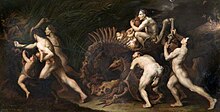
Hecate, the goddess of witchcraft and magic, is the chthonic counterpart of Apollo. They both are cousins, since their mothers – Leto and Asteria – are sisters. One of Apollo's epithets, Hecatos, is the masculine form of Hecate, and both names mean "working from afar". While Apollo presided over the prophetic powers and magic of light and heaven, Hecate presided over the prophetic powers and magic of night and chthonian darkness.[citation needed] If Hecate is the "gate-keeper", Apollo Agyieus is the "door-keeper". Hecate is the goddess of crossroads and Apollo is the god and protector of streets.[399]
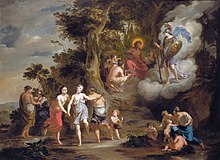
The oldest evidence found for Hecate's worship is at Apollo's temple in Miletos. There, Hecate was taken to be Apollo's sister counterpart in the absence of Artemis.[399] Hecate's lunar nature makes her the goddess of the waning moon and contrasts and complements, at the same time, Apollo's solar nature.
Athena
As a deity of knowledge and great power, Apollo was seen being the male counterpart of Athena. Being Zeus' favorite children, they were given more powers and duties. Apollo and Athena often took up the role of protectors of cities, and were patrons of some of the important cities. Athena was the principal goddess of Athens, Apollo was the principal god of Sparta.[400]
As patrons of arts, Apollo and Athena were companions of the Muses, the former a much more frequent companion than the latter.[401] Apollo was sometimes called the son of Athena and Hephaestus.[402]
In the Trojan War, as Zeus' executive, Apollo is seen holding the aegis like Athena usually does.[403] Apollo's decisions were usually approved by his sister Athena, and they both worked to establish the law and order set forth by Zeus.[404]
Apollo in the Oresteia

In Aeschylus' Oresteia trilogy, Clytemnestra kills her husband, King Agamemnon because he had sacrificed their daughter Iphigenia to proceed forward with the Trojan war. Apollo gives an order through the Oracle at Delphi that Agamemnon's son, Orestes, is to kill Clytemnestra and Aegisthus, her lover. Orestes and Pylades carry out the revenge, and consequently Orestes is pursued by the Erinyes or Furies (female personifications of vengeance).
Apollo and the Furies argue about whether the matricide was justified; Apollo holds that the bond of marriage is sacred and Orestes was avenging his father, whereas the Erinyes say that the bond of blood between mother and son is more meaningful than the bond of marriage. They invade his temple, and he drives them away. He says that the matter should be brought before Athena. Apollo promises to protect Orestes, as Orestes has become Apollo's supplicant. Apollo advocates Orestes at the trial, and ultimately Athena rules in favor of Apollo.
Roman Apollo
The Roman worship of Apollo was adopted from the Greeks.[405] As a quintessentially Greek god, Apollo had no direct Roman equivalent, although later Roman poets often referred to him as Phoebus.[citation needed] There was a tradition that the Delphic oracle was consulted as early as the period of the kings of Rome during the reign of Tarquinius Superbus.[406]
On the occasion of a pestilence in the 430s BCE, Apollo's first temple at Rome was established in the Flaminian fields, replacing an older cult site there known as the "Apollinare".[407] During the Second Punic War in 212 BCE, the Ludi Apollinares ("Apollonian Games") were instituted in his honor, on the instructions of a prophecy attributed to one Marcius.[408] In the time of Augustus, who considered himself under the special protection of Apollo and was even said to be his son, his worship developed and he became one of the chief gods of Rome.[409][405]
After the Battle of Actium, which was fought near a sanctuary of Apollo, Augustus enlarged Apollo's temple, dedicated a portion of the spoils to him, and instituted quinquennial games in his honour.[410] He also erected a new temple to the god on the Palatine hill.[411] Sacrifices and prayers on the Palatine to Apollo and Diana formed the culmination of the Secular Games, held in 17 BCE to celebrate the dawn of a new era.[412]
Festivals
The chief Apollonian festival was the Pythian Games held every four years at Delphi and was one of the four great Panhellenic Games. Also of major importance was the Delia held every four years on Delos. Athenian annual festivals included the Boedromia, Metageitnia,[413] Pyanepsia, and Thargelia. Spartan annual festivals were the Carneia and the Hyacinthia. Thebes every nine years held the Daphnephoria.
Attributes and symbols
Apollo's most common attributes were the bow and arrow. Other attributes of his included the kithara (an advanced version of the common lyre), the plectrum and the sword. Another common emblem was the sacrificial tripod, representing his prophetic powers. The Pythian Games were held in Apollo's honor every four years at Delphi. The bay laurel plant was used in expiatory sacrifices and in making the crown of victory at these games.[405]

The palm tree was also sacred to Apollo because he had been born under one in Delos. Animals sacred to Apollo included wolves, dolphins, roe deer, swans, cicadas (symbolizing music and song), ravens, hawks, crows (Apollo had hawks and crows as his messengers),[414] snakes (referencing Apollo's function as the god of prophecy), mice and griffins, mythical eagle–lion hybrids of Eastern origin.[405]
Homer and Porphyry wrote that Apollo had a hawk as his messenger.[415][414] In many myths Apollo is transformed into a hawk.[416][417][418] In addition, Claudius Aelianus wrote that in Ancient Egypt people believed that hawks were sacred to the god[419] and that according to the ministers of Apollo in Egypt there were certain men called "hawk-keepers" (ἱερακοβοσκοί) who fed and tended the hawks belonging to the god.[420] Eusebius wrote that the second appearance of the moon is held sacred in the city of Apollo in Egypt and that the city's symbol is a man with a hawklike face (Horus).[421] Claudius Aelianus wrote that Egyptians called Apollo Horus in their own language.[419]

As god of colonization,[422] Apollo gave oracular guidance on colonies, especially during the height of colonization, 750–550 BCE. According to Greek tradition, he helped Cretan or Arcadian colonists found the city of Troy. However, this story may reflect a cultural influence which had the reverse direction: Hittite cuneiform texts mention an Asia Minor god called Appaliunas or Apalunas in connection with the city of Wilusa attested in Hittite inscriptions, which is now generally regarded as being identical with the Greek Ilion by most scholars. In this interpretation, Apollo's title of Lykegenes can simply be read as "born in Lycia", which effectively severs the god's supposed link with wolves (possibly a folk etymology).
In literary contexts, Apollo represents harmony, order, and reason—characteristics contrasted with those of Dionysus, god of wine, who represents ecstasy and disorder. The contrast between the roles of these gods is reflected in the adjectives Apollonian and Dionysian. However, the Greeks thought of the two qualities as complementary: the two gods are brothers, and when Apollo at winter left for Hyperborea, he would leave the Delphic oracle to Dionysus. This contrast appears to be shown on the two sides of the Borghese Vase.
Apollo is often associated with the Golden Mean. This is the Greek ideal of moderation and a virtue that opposes gluttony.
In antiquity, Apollo was associated with the planet Mercury. The ancient Greeks believed that Mercury as observed during the morning was a different planet than the one during the evening, because each twilight Mercury would appear farther from the Sun as it set than it had the night before. The morning planet was called Apollo, and the one at evening Hermes/Mercury before they realised they were the same, thereupon the name 'Mercury/Hermes' was kept, and 'Apollo' was dropped.[1]
Apollo in the arts

Apollo is a common theme in Greek and Roman art and also in the art of the Renaissance. The earliest Greek word for a statue is "delight" (ἄγαλμα, agalma), and the sculptors tried to create forms which would inspire such guiding vision. Maurice Bowra notices that the Greek artist puts into a god the highest degree of power and beauty that can be imagined. The sculptors derived this from observations on human beings, but they also embodied in concrete form, issues beyond the reach of ordinary thought.[423]
The naked bodies of the statues are associated with the cult of the body which was essentially a religious activity.[424] The muscular frames and limbs combined with slim waists indicate the Greek desire for health, and the physical capacity which was necessary in the hard Greek environment.[425] The statues of Apollo and the other gods present them in their full youth and strength. "In the balance and relation of their limbs, such figures express their whole character, mental and physical, and reveal their central being, the radiant reality of youth in its heyday".[426]
Archaic sculpture
Numerous free-standing statues of male youths from Archaic Greece exist, and were once thought to be representations of Apollo, though later discoveries indicated that many represented mortals.[427] In 1895, V. I. Leonardos proposed the term kouros ("male youth") to refer to those from Keratea; this usage was later expanded by Henri Lechat in 1904 to cover all statues of this format.[428][429]
The earliest examples of life-sized statues of Apollo may be two figures from the Ionic sanctuary on the island of Delos. Such statues were found across the Greek-speaking world, the preponderance of these were found at the sanctuaries of Apollo with more than one hundred from the sanctuary of Apollo Ptoios, Boeotia alone.[430] Significantly more rare are the life-sized bronze statues. One of the few originals which survived into the present day—so rare that its discovery in 1959 was described as "a miracle" by Ernst Homann-Wedeking—is the masterpiece bronze, Piraeus Apollo. It was found in Piraeus, a port city close to Athens, and is believed to have come from north-eastern Peloponnesus. It is the only surviving large-scale Peloponnesian statue.[431]
Classical sculpture

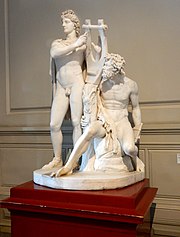
The famous Apollo of Mantua and its variants are early forms of the Apollo Citharoedus statue type, in which the god holds the cithara, a sophisticated seven-stringed variant of the lyre, in his left arm. While none of the Greek originals have survived, several Roman copies from approximately the late 1st or early 2nd century exist, of which an example is the Apollo Barberini.
Hellenistic Greece-Rome
Apollo as a handsome beardless young man, is often depicted with a cithara (as Apollo Citharoedus) or bow in his hand, or reclining on a tree (the Apollo Lykeios and Apollo Sauroctonos types). The Apollo Belvedere is a marble sculpture that was rediscovered in the late 15th century; for centuries it epitomized the ideals of Classical Antiquity for Europeans, from the Renaissance through the 19th century. The marble is a Hellenistic or Roman copy of a bronze original by the Greek sculptor Leochares, made between 330 and 320 BCE.[432]
The life-size so-called "Adonis" found in 1780 on the site of a villa suburbana near the Via Labicana in the Roman suburb of Centocelle is identified as an Apollo by modern scholars. In the late 2nd century CE floor mosaic from El Djem, Roman Thysdrus, he is identifiable as Apollo Helios by his effulgent halo, though now even a god's divine nakedness is concealed by his cloak, a mark of increasing conventions of modesty in the later Empire.[citation needed]
Another haloed Apollo in mosaic, from Hadrumentum, is in the museum at Sousse.[433] The conventions of this representation, head tilted, lips slightly parted, large-eyed, curling hair cut in locks grazing the neck, were developed in the 3rd century BCE to depict Alexander the Great.[434] Some time after this mosaic was executed, the earliest depictions of Christ would also be beardless and haloed.
Modern reception
Apollo often appears in modern and popular culture due to his status as the god of music, dance and poetry.
Postclassical art and literature

Dance and music
Apollo has featured in dance and music in modern culture. Percy Bysshe Shelley composed a "Hymn of Apollo" (1820), and the god's instruction of the Muses formed the subject of Igor Stravinsky's Apollon musagète (1927–1928). In 1978, the Canadian band Rush released an album with songs "Apollo: Bringer of Wisdom"/"Dionysus: Bringer of Love".[435]
Books
Apollo has been portrayed in modern literature, such as when Charles Handy in Gods of Management (1978) uses Greek gods as a metaphor to portray various types of organizational culture. Apollo represents a "role" culture where order, reason, and bureaucracy prevail.[436] In 2016, author Rick Riordan published the first book in the Trials of Apollo series,[437][438] publishing four other books in the series in 2017,[439] 2018,[440] 2019[441] and 2020.[442]
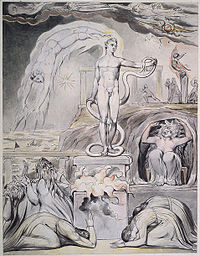
Film
Apollo has been depicted in modern films—for instance, by Keith David in the 1997 animated feature film Hercules,[443] by Luke Evans in the 2010 action film Clash of the Titans,[444] and by Dimitri Lekkos in the 2010 film Percy Jackson & the Olympians: The Lightning Thief.[445]
Video games
Apollo has appeared in many modern video games. Apollo appears as a minor character in Santa Monica Studio's 2010 action-adventure game God of War III with his bow being used by Peirithous.[446] He also appears in the 2014 Hi-Rez Studios Multiplayer Online Battle Arena game Smite as a playable character.[447]
Psychology and philosophy
In the philosophical discussion of the arts, a distinction is sometimes made between the Apollonian and Dionysian impulses, where the former is concerned with imposing intellectual order and the latter with chaotic creativity. Friedrich Nietzsche argued that a fusion of the two was most desirable.[448] Psychologist Carl Jung's Apollo archetype represents what he saw as the disposition in people to over-intellectualise and maintain emotional distance.[449]
Spaceflight
In spaceflight, the 1960s and 1970s NASA program for orbiting and landing astronauts on the Moon was named after Apollo, by NASA manager Abe Silverstein:
Apollo riding his chariot across the Sun was appropriate to the grand scale of the proposed program.[450]
— Abe Silverstein, Release 69-36
Genealogy
| Apollo's family tree [451] | |||||||||||||||||||||||||||||||||||||||||||||||||||||||||||||||||||||||||||||||||||||||||||||||||||||||||||||||||||||||||||||||||||||||||||||||||||||||||||||||||||||||||||||||||||||||||||||||||||||||||||||||||||||||||||||||||||||||||||||||||||||||||||||||||||||||||||||||||||||||||||||||||||||||||||||||||||||||||||||||||||||||||||||||||||||||||||||||||||||||||||||||||||||||||||||||||||||||||||||||||||||||||||||||||||||||||||||||||||||||||||||||||||||||||||||||||||||||||||||||||||||||||||||||||||||||||||||||||||||||||||||||||||||||||||||||||||||||||||||||||||||||||||||||||||||||||||||||||||||||||||||||||||||||||||||||||||||||||||||||||||||||||||||||||||||||||||||||||||||||||||||||||||||||||||||||||||||||||||||||||||||||||||||||||||||||||||||||||||||||||||||||||||||||||||||||||||||||||||||||||||||||||||||||||||||||||||||||||||||||||||||||||||||||||||||||||||||||||||||||||||||||||||||||||||||||||||||||||||||||||||||||||||||||||||||||||||||||||||||||||||||||||||||||||||||||||||||||||||||||
|---|---|---|---|---|---|---|---|---|---|---|---|---|---|---|---|---|---|---|---|---|---|---|---|---|---|---|---|---|---|---|---|---|---|---|---|---|---|---|---|---|---|---|---|---|---|---|---|---|---|---|---|---|---|---|---|---|---|---|---|---|---|---|---|---|---|---|---|---|---|---|---|---|---|---|---|---|---|---|---|---|---|---|---|---|---|---|---|---|---|---|---|---|---|---|---|---|---|---|---|---|---|---|---|---|---|---|---|---|---|---|---|---|---|---|---|---|---|---|---|---|---|---|---|---|---|---|---|---|---|---|---|---|---|---|---|---|---|---|---|---|---|---|---|---|---|---|---|---|---|---|---|---|---|---|---|---|---|---|---|---|---|---|---|---|---|---|---|---|---|---|---|---|---|---|---|---|---|---|---|---|---|---|---|---|---|---|---|---|---|---|---|---|---|---|---|---|---|---|---|---|---|---|---|---|---|---|---|---|---|---|---|---|---|---|---|---|---|---|---|---|---|---|---|---|---|---|---|---|---|---|---|---|---|---|---|---|---|---|---|---|---|---|---|---|---|---|---|---|---|---|---|---|---|---|---|---|---|---|---|---|---|---|---|---|---|---|---|---|---|---|---|---|---|---|---|---|---|---|---|---|---|---|---|---|---|---|---|---|---|---|---|---|---|---|---|---|---|---|---|---|---|---|---|---|---|---|---|---|---|---|---|---|---|---|---|---|---|---|---|---|---|---|---|---|---|---|---|---|---|---|---|---|---|---|---|---|---|---|---|---|---|---|---|---|---|---|---|---|---|---|---|---|---|---|---|---|---|---|---|---|---|---|---|---|---|---|---|---|---|---|---|---|---|---|---|---|---|---|---|---|---|---|---|---|---|---|---|---|---|---|---|---|---|---|---|---|---|---|---|---|---|---|---|---|---|---|---|---|---|---|---|---|---|---|---|---|---|---|---|---|---|---|---|---|---|---|---|---|---|---|---|---|---|---|---|---|---|---|---|---|---|---|---|---|---|---|---|---|---|---|---|---|---|---|---|---|---|---|---|---|---|---|---|---|---|---|---|---|---|---|---|---|---|---|---|---|---|---|---|---|---|---|---|---|---|---|---|---|---|---|---|---|---|---|---|---|---|---|---|---|---|---|---|---|---|---|---|---|---|---|---|---|---|---|---|---|---|---|---|---|---|---|---|---|---|---|---|---|---|---|---|---|---|---|---|---|---|---|---|---|---|---|---|---|---|---|---|---|---|---|---|---|---|---|---|---|---|---|---|---|---|---|---|---|---|---|---|---|---|---|---|---|---|---|---|---|---|---|---|---|---|---|---|---|---|---|---|---|---|---|---|---|---|---|---|---|---|---|---|---|---|---|---|---|---|---|---|---|---|---|---|---|---|---|---|---|---|---|---|---|---|---|---|---|---|---|---|---|---|---|---|---|---|---|---|---|---|---|---|---|---|---|---|---|---|---|---|---|---|---|---|---|---|---|---|---|---|---|---|---|---|---|---|---|---|---|---|---|---|---|---|---|---|---|---|---|---|---|---|---|---|---|---|---|---|---|---|---|---|---|---|---|---|---|---|---|---|---|---|---|---|---|---|---|---|---|---|---|---|---|---|---|---|---|---|---|---|---|---|---|---|---|---|---|---|---|---|---|---|---|---|---|---|---|---|---|---|---|---|---|---|---|---|---|---|---|---|---|---|---|---|---|---|---|---|---|---|---|---|---|---|---|---|---|---|---|---|---|---|---|---|---|---|---|---|---|---|---|---|---|---|---|---|---|---|---|---|---|---|---|---|---|---|---|---|---|---|---|---|---|---|---|---|---|---|---|---|---|---|---|---|---|---|---|---|---|---|---|---|---|---|---|---|---|---|---|---|---|---|---|---|---|---|---|---|---|---|---|---|---|---|---|---|---|---|---|---|---|---|---|---|---|---|---|---|---|---|---|---|---|---|---|---|---|---|---|---|---|---|---|---|---|---|---|---|---|---|---|---|---|---|---|---|---|---|---|---|---|---|---|---|---|---|---|---|---|---|---|---|---|---|---|---|---|---|---|---|---|---|---|---|---|---|---|---|---|---|---|---|---|---|---|---|---|---|---|---|---|---|---|---|---|---|---|---|---|---|---|---|---|---|---|---|---|---|---|---|---|---|---|---|---|---|---|---|---|---|---|---|---|---|---|---|---|---|---|---|---|---|---|---|---|---|---|---|---|---|---|---|---|---|---|---|---|---|---|---|---|---|---|---|---|---|---|---|---|---|---|---|
| |||||||||||||||||||||||||||||||||||||||||||||||||||||||||||||||||||||||||||||||||||||||||||||||||||||||||||||||||||||||||||||||||||||||||||||||||||||||||||||||||||||||||||||||||||||||||||||||||||||||||||||||||||||||||||||||||||||||||||||||||||||||||||||||||||||||||||||||||||||||||||||||||||||||||||||||||||||||||||||||||||||||||||||||||||||||||||||||||||||||||||||||||||||||||||||||||||||||||||||||||||||||||||||||||||||||||||||||||||||||||||||||||||||||||||||||||||||||||||||||||||||||||||||||||||||||||||||||||||||||||||||||||||||||||||||||||||||||||||||||||||||||||||||||||||||||||||||||||||||||||||||||||||||||||||||||||||||||||||||||||||||||||||||||||||||||||||||||||||||||||||||||||||||||||||||||||||||||||||||||||||||||||||||||||||||||||||||||||||||||||||||||||||||||||||||||||||||||||||||||||||||||||||||||||||||||||||||||||||||||||||||||||||||||||||||||||||||||||||||||||||||||||||||||||||||||||||||||||||||||||||||||||||||||||||||||||||||||||||||||||||||||||||||||||||||||||||||||||||||||
See also
Notes
- ^ Attic, Ionic, Homeric and Koinē Greek: Ἀπόλλων, romanized: Apóllōn, genitive: Ἀπόλλωνος, romanized: Apóllōnos Attic–Ionic pronunciation: [a.pól.lɔːn], [a.pól.lɔː.nos]; Koinē Greek: [aˈpol.lon], [aˈpol.lo.nos]
Doric Greek: Ἀπέλλων, romanized: Apéllōn, Doric Greek pronunciation: [a.pel.lɔ̂ːn]; Arcadocypriot Greek:: Ἀπείλων, romanized: Apeílōn, Arcadocypriot Greek: [a.pěː.lɔːn]; Aeolic Greek: Ἄπλουν, romanized: Áploun, Aeolic Greek: [á.ploːn]
Latin: Apollō, genitive: Apollinis, Classical Latin: [äˈpɔlːʲoː], [äˈpɔl.lʲɪ.nɪs̠]; Late Latin: [ɑˈpɔl.lɔ], [ɑˈpɔl.li.nis] - ^ Mousike (the art of the Muses) was an integral part of life in the ancient Greek world, and the term covered not only music but also dance, lyrics, theatre and the performance of poetry.
References
- ^ a b Price, Fred W. (1994). The Planet Observer's Handbook. New York City, New York: Cambridge University Press. p. 75. ISBN 0-521-78981-8.
- ^ Streck, Michael P. (2008), "Rašap A. In den schriftlichen Quellen", Reallexikon der Assyriologie (in German), p. 253
- ^ Krauskopf, I. 2006. "The Grave and Beyond." The Religion of the Etruscans. edited by N. de Grummond and E. Simon. Austin: University of Texas Press. p. vii, p. 73-75.
- ^ Schmitz, Leonhard (1867). "Agyieus". In Smith, William (ed.). Dictionary of Greek and Roman Biography and Mythology. Vol. 1. Boston: Little, Brown and Company. p. 83. Archived from the original on 14 May 2011. Retrieved 6 June 2008.
- ^ For the iconography of the Alexander–Helios type, see H. Hoffmann, 1963. "Helios", in Journal of the American Research Center in Egypt 2, pp. 117–23; cf. Yalouris 1980, no. 42.
- ^ Cicero, On the Nature of the Gods, § 2.68
- ^ Lucius Annaeus Cornutus, Greek Theology, § 65
- ^ Joseph Fontenrose, "Apollo and Sol in the Latin poets of the first century BC", Transactions of the American Philological Association 30 (1939), pp 439–55; "Apollo and the Sun-God in Ovid", American Journal of Philology 61 (1940) pp 429–44; and "Apollo and Sol in the Oaths of Aeneas and Latinus" Classical Philology 38.2 (April 1943), pp. 137–138.
- ^ R. S. P. Beekes, Etymological Dictionary of Greek, Brill, 2009, p. 118.
- ^ Herda, Alexander (2008). "Apollon Delphinios – Apollon Didymeus: Zwei Gesichter eines milesischen Gottes und ihr Bezug zur Kolonisation Milets in archaischer Zeit". Internationale Archäologie (in German). Arbeitsgemeinschaft, Symposium, Tagung, Kongress. Band 11: Kult(ur)kontakte. Apollon in Milet/Didyma, Histria, Myus, Naukratis und auf Zypern. Akten des Table Ronde in Mainz vom 11.–12. März 2004: 16. ISBN 978-3-89646-441-5.
- ^ "KN 842 E", DĀMOS: Database of Mycenaean at Oslo, University of Oslo. Department of Philosophy, Classics, History of Art and Ideas, archived from the original on 15 December 2016, retrieved 15 December 2014
- ^ Logozzo, Felicia; Poccetti, Paolo (7 November 2017). Ancient Greek Linguistics: New Approaches, Insights, Perspectives. Walter de Gruyter. p. 644. ISBN 9783110551754.
- ^ a b c van der Toorn, Karel; Becking, Bob; van der Horst, Pieter Willem (1999). Dictionary of Deities and Demons in the Bible. Brill. p. 73. ISBN 978-90-04-11119-6.
- ^ "The young men became grown-up kouroi, and Apollon was the megistos kouros (The Great Kouros) : Jane Ellen Harrison (2010): Themis: A study to the Social origins of Greek Religion Cambridge University Press. pp. 439–441, ISBN 1108009492
- ^ Leiden, E. J. (1985). Visible Religion. Volume IV–V. Approaches to Iconology. Brill. p. 143. ISBN 9004077723.
- ^ a b The word usually appears in plural: Hesychius: ἀπέλλαι (apellai), σηκοί ("folds"), ἐκκλησίαι ("assemblies"), ἀρχαιρεσίαι ("elections"): Nilsson, Vol. I, p. 556
- ^ Doric Greek verb: ἀπέλλάζειν ("to assemble"), and the festival ἀπέλλαι apellai), which surely belonged to Apollo. Nilsson, Vol I, p. 556.
- ^ Beekes, 2009, pp. 115, 118–119.
- ^ Campbell, Mike. "Meaning, Origin and History of the Name Apollo". Behind the Name. Retrieved 30 July 2013.
- ^ The ἁπλοῦν suggestion is repeated by Plutarch in Moralia in the sense of "unity".
- ^ a b Freese 1911, p. 184.
- ^ R. S. P. Beekes, Etymological Dictionary of Greek, Brill, 2009, p. 1168.
- ^ πέλλα. Liddell, Henry George; Scott, Robert; A Greek–English Lexicon at the Perseus Project.
- ^ Nilsson Vol I, p. 558
- ^ The reading of Apaliunas and the possible identification with Apollo is due to Emil Forrer (1931). It was doubted by Kretschmer, Glotta XXIV, p. 250. Martin Nilsson (1967), Vol I, p. 559
- ^ Angel, John L.; Mellink, Machteld Johanna (1986). Troy and the Trojan War: A Symposium Held at Bryn Mawr College, October 1984. Bryn Mawr Commentaries. p. 42. ISBN 978-0-929524-59-7.
- ^ Melchert, Harold Craig (1994). Anatolian Historical Phonology. Rodopi. ISBN 978-9051836974.
- ^ Immerwahr, Sara Anderson; Chapin, Anne Proctor (2004). Charis: Essays in Honor of Sara A. Immerwahr. Amer School of Classical. p. 254. ISBN 978-0-87661-533-1.
- ^ R. S. P. Beekes, Etymological Dictionary of Greek, Brill, 2009, p. 1582.
- ^ Apollonius of Rhodes, 2.1730;Apollodorus, 1.9.26.
- ^ a b c d Álvaro Jr., Santos, Allan. Simbolismo divino. Allan Álvaro, Jr., Santos.
- ^ Aelian, On the Nature of Animals 4. 4 (A.F. Scholfield, tr.)
- ^ Ovid, Metamorphoses 13.715.
- ^ Strabo, x. p. 451
- ^ Wiliam Smith. Dictionary of Greek and Roman Biography and Mythology Acraepheus
- ^
 Schmitz, Leonhard (1870). "Epactaeus". In Smith, William (ed.). Dictionary of Greek and Roman Biography and Mythology.
Schmitz, Leonhard (1870). "Epactaeus". In Smith, William (ed.). Dictionary of Greek and Roman Biography and Mythology.
- ^ Σμινθεύς in Liddell and Scott.
- ^ The epithet "Smintheus" has historically been confused with σμίνθος, "mouse", in association with Apollo's role as a god of disease
- ^ Suda, nu, 31
- ^ a b Harry Thurston Peck, Harpers Dictionary of Classical Antiquities (1898), Eutresis
- ^ Smith, William (1873). "Acesius". Dictionary of Greek and Roman Biography and Mythology – via Perseus Digital Library at Tufts University.
- ^ Euripides, Andromache 901
- ^ παιών
- ^ κλάρος
- ^ Pausanias, Description of Greece, 1.32.2
- ^ Μουσαγέτας in Liddell and Scott.
- ^ Homer, Odyssey 17.494
- ^ See ἀκερσεκόμης
- ^ Pausanias, Description of Greece, § 3.25.3
- ^ A Dictionary of Greek and Roman biography and mythology, Boedromius
- ^ Miranda J. Green, Dictionary of Celtic Myth and Legend, Thames and Hudson Ltd, 1997
- ^ Corpus Inscriptionum Latinarum XIII, 1863–1986; A. Ross, Pagan Celtic Britain, 1967; M.J. Green, The Gods of the Celts, 1986, London
- ^ J. Zwicker, Fontes Historiae Religionis Celticae, 1934–36, Berlin; Corpus Inscriptionum Latinarum V, XI, XII, XIII; J. Gourcest, "Le culte de Belenos en Provence occidentale et en Gaule", Ogam 6.6 (1954:257–262); E. Thevonot, "Le cheval sacre dans la Gaule de l'Est", Revue archeologique de l'Est et du Centre-Est (vol 2), 1951; [], "Temoignages du culte de l'Apollon gaulois dans l'Helvetie romaine", Revue celtique (vol 51), 1934.
- ^ W.J. Wedlake, The Excavation of the Shrine of Apollo at Nettleton, Wiltshire, 1956–1971, Society of Antiquaries of London, 1982.
- ^ M. Szabo, The Celtic Heritage in Hungary (Budapest 1971)
- ^ a b Divinites et sanctuaires de la Gaule, E. Thevonat, 1968, Paris
- ^ a b La religion des Celtes, J. de Vries, 1963, Paris
- ^ J. Le Gall, Alesia, archeologie et histoire (Paris 1963).
- ^ Corpus Inscriptionum Latinarum XIII
- ^ Oman, Sir Charles William Chadwick (1895). A History of Greece from the Earliest Times to the Death of Alexander the Great. Longmans, Green, & Company.
- ^ "Apollo | Facts, Symbols, Powers, & Myths | Britannica". www.britannica.com. Retrieved 1 March 2023.
- ^ a b Burkert 1985:143.
- ^ Martin Nilsson (1967). "Die Geschicte der Giechischen Religion, Vol I." C.F.Beck Verlag.Munchen. p. 529
- ^ Burkert, Walter. Greek Religion, 1985:144.
- ^ "Apollo Victorious over the Python". The Walters Art Museum. Retrieved 21 June 2013.
- ^ Pausanias VIII 41, 8-IV 34, 7-Sittig. Nom P. 48. f-Aristoph. Vesp. V. 61-Paus. I 3, 4. Martin Nilsson (1967) Vol I, pp. 540, 544
- ^ [1]: Harper's Dictionary of classical antiquity
- ^ οὔλιος in Liddell and Scott.
- ^ Graf, Fritz (2008). Apollo. Taylor & Francis. p. 66. ISBN 978-0-203-58171-1.
- ^ Paieon (Παιήων) puts pain-relieving medicines on the wounds of Pluton and Ares ( Ilias E401). This art is related with Egypt: (Odyssey D232): M. Nilsson Vol I, p. 543
- ^ Schofield, Louise (2007). The Mycenaeans. The British Museum Press. p. 160. ISBN 978-0-89236-867-9.
- ^ "KN V 52+". Deaditerranean: Minoan Linear A & Mycenaean Linear B. Archived from the original on 18 March 2016. Retrieved 17 March 2014.
- ^ Chadwick, John (1976). The Mycenaean World. Cambridge, UK: Cambridge University Press. p. 89. ISBN 978-0-521-29037-1. At Google Books.
- ^ Ἐπὶ καταπαύσει λοιμῶν καὶ νόσων ᾄδόμενος. Which is sung to stop the plagues and the diseases. Proklos: Chrestom from Photios Bibl. code. 239, p. 321: Martin Nilsson. Die Geschicthe der Griechischen religion. Vol I, p. 543
- ^ Homer (1 June 2000). The Iliad. Translated by Butler, Samuel.
- ^ "The conception that the diseases come from invisible shots sent by magicians or supernatural beings is common in primitive people and also in European folklore. In North-Europe they speak of the "Elf-shots". In Sweden where the Lapps were called magicians, they speak of the "Lappen-shots". Martin Nilsson (1967). Vol I, p. 541
- ^ Ilias A 314. Martin Nilsson (1967). Vol I, p. 543
- ^ Herbert W. Park (1956). The delphic oracle. Vol. I, p. 3
- ^ Graf, Apollo, pp. 104–113; Burkert also notes in this context Archilochus Fr. 94.
- ^ Burkert, p. 255.
- ^ Jane Ellen Harrison (2010): Themis: A study to the Social origins of Greek Religion. Cambridge University Press. p. 441. ISBN 1108009492
- ^ Compare: Baetylus. In Semitic: sacred stone
- ^ Martin Nilsson (1967). Vol I. p. 556
- ^ Huxley, George (6 June 1975). "Cretan Paiawones". Greek, Roman, and Byzantine Studies. 16 (2): 119–124. ISSN 2159-3159.
- ^ Martin Nilsson (1967). Vol I, p. 554 A4
- ^ Martin Nilsson (1967), Vol I, pp. 499–500
- ^ Martin Nilsson. Die Geschichte der Griechische Religion Vol I, pp. 563–564
- ^ Paul Kretschmer (1936). Glotta XXIV p. 250. Martin Nilsson (1967). Vol I, p. 559.
- ^ "EDIANA – Corpus". www.ediana.gwi.uni-muenchen.de. Retrieved 8 March 2018.
- ^ "The Archaeological Exploration of Sardis". sardisexpedition.org. Retrieved 8 March 2018.
- ^ Martin Nilsson, Die Geschichte der Griechische Religion. vol. I (C. H. Beck), 1955:563f.
- ^ Martin Nilsson (1967). Vol I, p. 561.
- ^ For Śarva as a name of Shiva see: Apte, p. 910.
- ^ For the association between Rudra and disease, with Rigvedic references, see: Bhandarkar, p. 146.
- ^ Diodorus Siculus, Library 1–7, 5.77.5
- ^ Diodorus Siculus, Library 1–7, 5.77.5 – GR
- ^ Herodotus, 1.46.
- ^ Lucian (attrib.), De Dea Syria 35–37.
- ^ To know what a thing is, we must know the look of it": Rhys Carpenter: The esthetic basis of Greek art. Indiana University Press. p. 108
- ^ C. M. Bowra (1957), The Greek Experience, p. 166.
- ^ William Dinsmoor (1950),The architecture of Ancient Greece, p. 218, ISBN 0-8196-0283-3
- ^ a b William Smith. A Dictionary of Greek and Roman Antiquities, John Murray, London, 1875. p. 384
- ^ Hellenic Ministry of culture, Temple of Apollo Daphnephoros Archived 12 September 2014 at the Wayback Machine
- ^ Rufus B. Richardson, "A Temple in Eretria" The American Journal of Archaeology and of the History of the Fine Arts, 10.3 (July – September 1895:326–337)
- ^ Martin Nilsson (1967). Vol I, p. 529
- ^ Robertson pp. 56, 323.
- ^ a b Spivey, p. 112
- ^ Robertson p. 87
- ^ a b c d D.S Robertson(1945):A handbook of Greek and Roman architecture, Cambridge University Press pp. 324–329
- ^ Robertson, p. 98
- ^ Mertens 2006, pp. 104–109.
- ^ IG XIV 269
- ^ Temple of Apollo at Delphi, Ancient-Greece.org
- ^ Smith, William (1850). New classical dictionary of biography, mythology, and geography. J. Murray. p. 1. Retrieved 14 October 2017.
- ^ See reports of the German Archaeological Institute in Archaeological Reports for 2008/9 43–45
- ^ Hellenic Ministry of Culture: The Temple of Epicurean Apollo Archived 9 May 2007 at the Wayback Machine.
- ^ Temple of Apollo Epicurius at Bassae Archived 31 December 2006 at the Wayback Machine, World Heritage Site.
- ^ Ministry of culture. Temple of Apollo Pythios Sotir Archived 2 December 2014 at the Wayback Machine
- ^ Peter Schneider: Neue Funde vom archaischen Apollontempel in Didyma. In: Ernst-Ludwig Schwandner (ed.): Säule und Gebälk. Zu Struktur und Wandlungsprozeß griechisch-römischer Architektur. Bauforschungskolloquium in Berlin vom 16.-18. Juni 1994. Diskussionen zur Archäologischen Bauforschung
- ^ Smith 1873, s.v. Clarus.
- ^ Prophecy centre of Apollo Clarius
- ^ Bresson (2007) 154-5, citing the excavations reports of Özgünel (2001).
- ^ Robertson p. 333
- ^ Suda, pi.3130
- ^ 1800-year-old stele on way back from Italy after 23 years
- ^ "Slab with marching ancient Greek warriors discovered at Apollo temples on ancient black sea island in Bulgaria's Sozopol". Archived from the original on 30 March 2021. Retrieved 1 April 2021.
- ^ Strabo, Geography, 16.3.2.
- ^ Photius, Bibliotheca excerpts, 190.51
- ^ Pausanias, Description of Greece, 3.12
- ^ a b Robertson pp. 200–201
- ^ Perseus tufts: Falerii Veteres
- ^ Davidson CSA :Temple of Apollo, Pompeii Archived 6 January 2015 at the Wayback Machine
- ^ Livy 4.25
- ^ Livy 34.43
- ^ A topographical dictionary of Ancient Rome
- ^ Testa, Michael (19 March 2002). "New find at Mdina most important so far in old capital". Times of Malta. Archived from the original on 13 April 2016.
- ^ Homer, Iliad 21.499
- ^ "Homeric hymn to Delian Apollo"
- ^ "Callimachus, Hymn to Delos"
- ^ Pindar, Pa. VII b
- ^ Pindar, Processional Song on Delos
- ^ Pindar, Pa. XII
- ^ Pseudo-Hyginus, Fabulae 53
- ^ Pseudo-Hyginus, Fabulae 140
- ^ Aelian, Characteristics of Animals 4. 4
- ^ Aelian, Characteristics of Animals 10. 26
- ^ Homer, Iliad
- ^ Libanius, Progymnasmata 2.25
- ^ Strabo, Geography 14. 1. 20
- ^ Theognis, Fragment 1. 5
- ^ Servius, Commentary on Virgil's Aeneid 3.7
- ^ Apollodorus, Bibliotheca 1.21
- ^ Virgil, Aeneid, 3.80
- ^ Nonnus, Dionysiaca
- ^ ἑβδομαγενής in Liddell and Scott.
- ^ Pindar, Pindar, Olympian Ode
- ^ Apollonius Rhodius, Argonautica, 2. 674.
- ^ a b c d e f g Callimachus, Hymn II to Apollo.
- ^ Joseph Eddy Fontenrose, Python: A Study of Delphic Myth and Its Origins
- ^ Plutarch, de his qui sero a num. pun. p. 557F
- ^ Diodorus Siculus, Library of History 2. 47. 1 – 6
- ^ Anna Afonasina, Shamanism and the Orphic tradition
- ^ Fritz Graf, Apollo
- ^ Apollonius Rhodius, Argonautica, 4. 594.
- ^ Plutarch, Moralia 657e
- ^ a b Aeschylus, Eumenides
- ^ Callimachus, Hymn to Apollo
- ^ a b Callimachus, Hymn to Delos
- ^ a b Alcaeus, Hymn to Apollo
- ^ Timothy P. Bridgman, Hyperboreans: Myth and History in Celtic-Hellenic Contacts
- ^ Homeric Hymn 4 to Hermes 550.
- ^ Apollodorus, Bibliotheca 1.41.
- ^ Diodorus Siculus, 5.74.5.
- ^ Ovid, Metamorphoses 6. 313
- ^ Antoninus Liberalis, Metamorphoses 35
- ^ Homeric hymn to Pythian Apollo
- ^ Simonides, Fragment 573
- ^ Statius, Thebaid 5. 531
- ^ a b Ovid, Metamorphoses 1. 434
- ^ Euripides, Iphigenia in Tauris 1234
- ^ Limenus, Paean to Apollo
- ^ Greek Anthology, 3.6
- ^ a b Pseudo-Hyginus, Fabulae 140
- ^ Athenaeus, Deipnosophists 15.62
- ^ Callimachus, Hymn to Apollo 97
- ^ a b Strabo, Geography 9. 3. 12
- ^ Homeric Hymn to Pythian Apollo
- ^ Himerius, Orations
- ^ 1; Orphic Hymn 79 to Themis
- ^ Pindar, fr. 55 SM
- ^ Henry, W.B. (I.) Rutherford Pindar's Paeans. A Reading of the Fragments with a Survey of the Genre
- ^ Euripides, Iphigenia in Tauris 1259
- ^ Pausanias, Description of Greece 2. 7. 7
- ^ Pausanias, Description of Greece 2. 30. 3
- ^ Statius, Thebaid 1. 561
- ^ Aelian, Varia Historia 3.1
- ^ Temple of Athena Pronaia was the first one met by the visitor who came to Delphi on foot from the eastern road.
- ^ Aristonous, Paean to Apollo
- ^ Scholiast on Euripides, Alcestis. 1 citing Anaxandrides
- ^ Hesiod, The Great Eoiae Fragment 16
- ^ Antoninus Liberalis, Metamorphoses 23
- ^ Strabo, Geography 10.1.10
- ^ Apollodorus, Bibliotheca 3.10.4
- ^ Plutarch, Amatorius 761e
- ^ Apollodorus, Bibliotheca 3.4.2
- ^ Servius, Commentary on Aeneid 2.761
- ^ Plutarch, Why the Oracles Cease To Give Answers 421c
- ^ Apollo, Fritz Graf
- ^ a b c d Ptolemy Hephaestion, New History Book 7
- ^ Strabo, Geography 9. 3. 10
- ^ Statius, Thebaid 6. 8
- ^ a b Homer, Odyssey 11. 576
- ^ a b Apollodorus, Bibliotheca 1.22
- ^ Hyginus, Fabulae 55
- ^ Apollonius Rhodius, Argonautica 1. 758
- ^ Quintus Smyrnaeus, Fall of Troy 3. 390
- ^ Scholia on Pindar, Pythian Odes 4.160 citing Pherecydes
- ^ Pausanias, Description of Greece 10. 11. 1
- ^ a b c Apollodorus, 3.10.4.
- ^ a b c Apollodorus, 1.9.15.
- ^ a b Hyginus, Fabulae 50–51.
- ^ Hyginus, Fabulae 10
- ^ Apollodorus, Bibliotheca 2.5
- ^ Homer, The Iliad 21.434
- ^ Pindar, Olympian Odes viii. 39, &c.
- ^ Hesiod, Catalogues of Women Fragment 83
- ^ Stesichorus, Fr. 108; Tzetzes, On Lycophron 266; Porphyry in his Omissions states that Ibycus, Alexander, Euphorion and Lycophron all made Hector the son of Apollo.
- ^ Pindar, Olympian Ode 6
- ^ Apollonius Rhodius. Argonautica ii, 846 ff
- ^ The Cyclopedia, Or, Universal Dictionary of Arts, Sciences, and Literature, Volume 37
- ^ Plato, Laws 653.4
- ^ The prefix A means "without" or "not", and polloi means "many", thus Apollo means "not many" or "united", referring to his ability to create harmony.
- ^ Plato, Cratylus
- ^ Aelian, On the nature of Animals 11. 1
- ^ Aelian, Varia Historia, 2. 26
- ^ Diogenes Laërtius, 8.13
- ^ Iamblichus, Vit. Pyth. 8.91.141
- ^ Landels, John G (1999) Music in Ancient Greece and Rome
- ^ Iliad (i. 603)
- ^ Detienne, Marcel (2001) Forgetting Delphi between Apollo and Dionysus
- ^ "Homeric Hymn to Hermes (IV, 1–506)". Perseus. Retrieved 18 March 2018.
- ^ Diodorus Siculus[incomplete short citation]
- ^ Hard, p. 162.
- ^ Brown, Norman O. (1947). Hermes the Thief: The Evolution of a Myth. Madison: University of Wisconsin Press. p. 93. ISBN 0-940262-26-6.
- ^ a b Apuleius, Florida 3.2
- ^ a b Diodorus Siculus, Library of History 5. 75. 3
- ^ Philostratus the Younger, Imagines 2 (trans. Fairbanks)
- ^ Man Myth and Magic by Richard Cavendish
- ^ Hyginus, Fabulae 165.
- ^ Apostle Arne Horn, The Book of Eusebius #4
- ^ Homer, Iliad, 11.20–23.
- ^ Eustathius on Iliad; cf. also scholia on the same passage
- ^ Homer, Hymn to Pythian Apollo
- ^ Apollonius of Rhodes, Argonautica
- ^ John Potter, Archaeologia Graeca: Or, The Antiquities of Greece, Volume 1
- ^ Homer, the Ilaid 1
- ^ Eugammon of Cyrene, Telegony Fragment
- ^ Benjamin Sammons, Device and Composition in the Greek Epic Cycle
- ^ Nonnus, Dionysiaca 13
- ^ Nonnus, Dionysiaca 27
- ^ Nonnus, Dionysiaca 24
- ^ Statius, Thebaid 7
- ^ Apollodorus, 1.6.2.
- ^ Pindar, Pythian 8.12–18.
- ^ Grimal, s.v. Aloadae, p. 34.
- ^ Homer, Odyssey 11.305.
- ^ Hyginus, Fabulae 28.
- ^ Philostratus the Elder, Imagines 2.19.
- ^ Herodotus, Histories 5. 7. 10
- ^ Orphic Hymn 34 to Apollon, 21 (Athanassakis and Wolkow, pp. 30–31).
- ^ Antoninus Liberalis, Metamorphoses 6; Grimal, s.v. Periphas (2), p. 359.
- ^ Diodorus Siculus, Library of History, 5. 62. 3–4
- ^ Valerius Flaccus, Argonautica 4. 60
- ^ Apollodorus, 2.4.12.
- ^ Apollodorus, 2.5.3.
- ^ Pausanias, Description of Greece 3. 21. 8
- ^ Plato, The Symposium
- ^ a b Strabo, Geography, 10.2.8.
- ^ Aelian, On Animals 11. 8
- ^ Hyginus, Fabulae 150.
- ^ Apollodorus, 1.3.4.
- ^ Asclepiades, Tragoidoumena 6 (from Scholia ad Pindari Pythia 4.313a)
- ^ Scholiast on Apollonius Rhodius, Arg. iv. 828
- ^ Scholia on Tzetzes' Exegesis in Iliadem 1.126 [= Hesiod Catalogue of Women fr. 83].
- ^ Pausanias, Description of Greece 9
- ^ Antoninus Liberalis, Metamorphoses 12; Ovid, Metamorphoses 7.350; Smith 1873, s.v. Cycnus (1).
- ^ Stesichorus, Fr.108
- ^ Antoninus Liberalis, Metamorphoses, 32; Ovid, Metamorphoses 9.330.
- ^ Pausanias, 9.10.5–6.
- ^ Ovid, Metamorphoses 10.143 ff.
- ^ αἰαῖ, αἴ in Liddell and Scott.
- ^ Smith 1890, s.v. Hyacinthia.
- ^ Ovid, Metamorphoses 10.106–10.142; Tripp, s.v. Cyparissus.
- ^ Callimachus, Hymn to Apollo, 49.
- ^ a b Plutarch, Life of Numa, 4.5.
- ^ Keaveney, Arthur (1 January 1984). "A Note on Servius, Ad Aeneid 7, 637". Philologus. 128 (1–2): 138–139. doi:10.1524/phil.1984.128.12.138. ISSN 2196-7008. S2CID 164720549.
- ^ Plutarch, Amatorius 17
- ^ Ovid, Ars Amatoria 2.239
- ^ Tibullus, Elegies 2.3
- ^ Tibullus, Elegies 2
- ^ Pepin, Ronald E. (2008). The Vatican Mythographers. Fordham Univ Press. ISBN 9780823228928.
- ^ Ptolemy Hephaestion, New History Book 4 (summary from Photius, Myriobiblon 190)
- ^ Nonnus, Dionysiaca, 11. 258; 19. 181.
- ^ Valerius Flaccus, Argonautica 4.465
- ^ Pindar, Pythian Ode 2 lines 15–17 with scholia
- ^ Photius, 'Bibliotheca excerpts'
- ^ Antoninus Liberalis, Metamorphoses, 23 [= Hesiod, Megalai Ehoiai fr. 16]; Smith 1873, s.v. Hymen; Grimal, s.v. Hymenaeus.
- ^ Smith 1873, s.v. Iapis.
- ^ Plutarch, Numa 4.5; cf. Hyginus, De Astronomica, 2.14.
- ^ Eumelus, Fragment 35 (from Tzetzes, On Hesiod's Works & Days 23)
- ^ Smith, s.v. Musae; Plutarch, Symposiacs 9.14.4.
- ^ Plutarch, Of the Names of Rivers and Mountains, and Of Such Things as are to be Found Therein
- ^ Tripp, s.v. Acacallis or Acalle, p. 1; Apollonius of Rhodes, 4.1491–4.
- ^ Antoninus Liberalis, Metamorphoses 30.
- ^ Scholia on Apollonius Rhodius, 1491 ff.[non-primary source needed]
- ^ Pausanias, 10.6.5.
- ^ Smith, s.v. Oaxes; Servius on Virgil's Eclogue 1.65.
- ^ Apollodorus, 3.10.1.
- ^ Pseudo-Plutarch, De fluviis, 7.
- ^ Photius, Lexicon s. v. Linos[non-primary source needed]
- ^ Apollodorus, 3.1.2.
- ^ Smith, s.v. Deione.
- ^ Photius, Lexicon, s. v. Eumolpidai[non-primary source needed]
- ^ Hard, p. 424; Apollodorus, 3.10.3.
- ^ Smith, s.v. Arsinoe (3).
- ^ Pliny the Elder, Natural History, 7.196, pp. 638, 639.
- ^ a b Apollodorus, 1.3.2.
- ^ Peck, s.v. Ialĕmus.
- ^ Smith, s.v. Urania (1); Hyginus, Fabulae 161.
- ^ Brill's New Pauly, s.v. Terpsichore; Suda λ 568.
- ^ Pausanias, 10.6.3.
- ^ Grimal, s.v. Delphus, p. 131; Pausanias, 10.6.4.
- ^ Pausanias, 10.6.4.
- ^ Brill's New Jacoby, s.v. Philammon (1); Ovid, Metamorphoses 11.316–7.
- ^ Smith, s.v. Philammon; Hyginus, Fabulae 161.
- ^ BNJ 3 F120 [= Scholia on Homer's Odyssey, 19.432].
- ^ Pausanias, 2.5.8.
- ^ Parada, s.v. Chrysothemis, p. 47; Hyginus, De Astronomica 2.25.1.
- ^ Hard, p. 149; Homeric Hymn to Asclepius (16), 1–4; Diodorus Siculus, 5.74.6.
- ^ Smith, s.v. Lycorus; Pausanias, 10.6.3.
- ^ Euripides, Ion 10.
- ^ Brill's New Pauly, s.v. Aristaeus (1); Smith, s.v. Aristaeus; Hesiod, Catalogue of Women fr. 159, pp. 266, 267; Hyginus, Fabulae 161.
- ^ RE, s.v. Autuchos; Scholia on Apollonius Rhodius, Argonautica, 2.498.
- ^ Tripp, s.v. Idmon, p. 316.
- ^ RE, Danais (4); Tzetzes on Lycophron, 77.
- ^ Brill's New Pauly, s.v. Dia (4); Tzetzes on Lycophron, 480; Scholia on Apollonius Rhodius, Argonautica, 1.1213.
- ^ Antoninus Liberalis, 32.
- ^ a b Hyginus, Fabulae 161.
- ^ Smith, s.v. Iamus; Pindar, Olympian 6.35 ff.
- ^ Smith, s.v. Amphiaraus; Hyginus, Fabulae 70.
- ^ Gantz, p. 561; Stesichorus, fr. 224 Campbell, pp. 156, 157 [= Euphorion, fr. 56 Powell = Scholia on Lycophron's Alexandra, 265]; Ibycus, fr. 295 PMG (Page, 152) [= Scholia on Homer's Iliad, 3.314].
- ^ Antoninus Liberalis, Metamorphoses 12.
- ^ Grimal, s.v. Icadius, p. 226; Servius on Virgil's Aeneid, 3.332.
- ^ RE, s.v. Pataros (1); Stephanus of Byzantium, s.v. Patara.
- ^ Smith, s.v. Mopsus (2); Strabo, Geographica 14.5.16.
- ^ Pausanias, 9.10.6.
- ^ Antoninus Liberalis, 13.
- ^ Photius, Lexicon, s.v. Kynneios.[non-primary source needed]
- ^ Parada, s.v. Lycomedes (3), p. 108; Pausanias, 7.4.1.
- ^ RE, s.v. Apollon.
- ^ Apollodorus, 1.7.6.
- ^ Apollodorus, E.3.23.
- ^ Brill's New Pauly, s.v. Psamathe (2); Pausanias, 2.19.8.
- ^ BNJ 3 F48 [= Strabo, Geographica 10.3.21.
- ^ Brill's New Pauly, s.v. Thalia (1); Apollodorus, 1.3.4.
- ^ Smith, s.v. Rhoeo; Diodorus Siculus, 5.62.1.
- ^ RE, s.v. Apollon; Etymologicum Magnum 507.54.
- ^ Grimal, s.v. Cicones, p. 102; Etymologicum Magnum 513.37.
- ^ Plutarch, Lucullus 23.6.
- ^ Smith, s.v. Stilbe; Diodorus Siculus, 4.69.1.
- ^ Brill's New Pauly, s.v. Aeneus.
- ^ Brill's New Pauly, s.v. Zeuxippus (2); Pausanias, 2.6.7.
- ^ Tzetzes, Chiliades 13.599–600; Alciphron, Letters 1.16.
- ^ Licymnius, fr. 768a.[non-primary source needed]
- ^ Smith, s.v. Galeus; Stephanus of Byzantium, s.v. Galeotai.
- ^ Pausanias, 9.40.6.
- ^ Brill's New Pauly, s.v. Trophonius.
- ^ Smith, s.v. Acraephus; Stephanus of Byzantium, s.v. Akraiphia.
- ^ Brill's New Pauly, s.v. Chariclo (1); Scholia on Pindar, Pythian 4.181.
- ^ Grimal, s.v. Erymanthus (1), p. 153.
- ^ Suda μ 177.
- ^ Antoninus Liberalis, Metamorphoses 4.
- ^ Pausanias, 8.25.4.
- ^ Brill's New Pauly, s.v. Phemonoe.
- ^ Grimal, s.v. Pisus (2), p. 376; Servius on Virgil's Aeneid, 10.179.
- ^ Eumelus, fr. 35 West, pp. 250, 251.
- ^ Brill's New Pauly, s.v. Troilus (1); Apollodorus, 3.12.5.
- ^ "The love-stories themselves were not told until later." Karl Kerenyi, The Gods of the Greeks 1951:140.
- ^ Hyginus, Fabulae 203.
- ^ Ovid, Metamorphoses 1.452–567; Tripp, s.v. Daphne.
- ^ Apollodorus, 1.7.8–9; cf. Homer, Iliad 9.557–560.
- ^ Statius, Thebaid 1.696 ff.
- ^ Ovid, Metamorphoses 14.129–154
- ^ Campanile, Domitilla; Carlà-Uhink, Filippo; Facella, Margherita (23 February 2017). TransAntiquity: Cross-Dressing and Transgender Dynamics in the Ancient World. Routledge. p. 57. ISBN 9781138941205.
- ^ Eustath. ad Hom. p. 1197
- ^ The Oxford Encyclopedia of Ancient Greece and Rome s.v. Artemis, p. 268
- ^ G. Shipley, "The Extent of Spartan Territory in the Late Classical and Hellenistic Periods", The Annual of the British School at Athens, 2000.
- ^ Rufus B. Richardson, "A Temple in Eretria" The American Journal of Archaeology and of the History of the Fine Arts, 10.3 (July – September 1895:326–337); Paul Auberson, Eretria. Fouilles et Recherches I, Temple d'Apollon Daphnéphoros, Architecture (Bern, 1968). See also Plutarch, Pythian Oracle, 16.
- ^ a b Carol M. Mooney, B.A., Hekate: Her Role And Character In Greek Literature From Before The Fifth Century B.C.
- ^ "APOLLO, THE YOUNG, AND THE CITY – KEY THEMES – Apollo – Fritz Graf".
- ^ Peter Dawkins, The Shakespeare Enigma
- ^ Cicero, De Natura Deorum 3.22.
- ^ Homer, Iliad 15.308.
- ^ 1.Homer, Iliad, Euripides, Ion, Aeschylus, Oresteia
- ^ a b c d Freese 1911, p. 185.
- ^ Livy 1.56.
- ^ Livy 3.63.7, 4.25.3.
- ^ Livy 25.12.
- ^ J. H. W. G. Liebeschuetz (1979). Continuity and Change in Roman Religion. Oxford: Oxford University Press. pp. 82–85. ISBN 978-0-19-814822-7.
- ^ Suetonius, Augustus 18.2; Cassius Dio 51.1.1–3.
- ^ Cassius Dio 53.1.3.
- ^ Inscriptiones Latinae Selectae 5050, translated by Beard, Mary; North, John; Price, Simon (1998). Religions of Rome: Volume 2: A Sourcebook. Cambridge: Cambridge University Press. p. 5.7b. ISBN 978-0-521-45015-7.
- ^ Smith 1890, s.v. MACELLUM, MATRA'LIA, METAGEI'TNIA.
- ^ a b Porphyry, De abstinentia, 3.5
- ^ Homer, Odyssey, 15.493
- ^ Antoninus Liberalis, Metamorphoses, 28
- ^ Ovid, Metamorphoses, 6.103
- ^ Ovid, Metamorphoses, 11.318
- ^ a b Aelian, Characteristics of Animals, 10.14
- ^ Aelian, Characteristics of Animals, 7.9
- ^ Eusebius, Preparation of the Gospels, 3.12.1
- ^ Shachar, Ilan (2 June 2008). "Greek colonization and the eponymous apollo". Mediterranean Historical Review. 15 (2): 1–26. doi:10.1080/09518960008569776. S2CID 162333182.
- ^ C. M. Bowra, The Greek Experience, pp. 148, 149.
- ^ C. M. Bowra, The Greek Experience, pp. 148, 150.
- ^ C. M. Bowra, The Greek Experience, p. 5.
- ^ C. M. Bowra, The Greek Experience, p. 150.
- ^ Delphi, 467, 1524
- ^ V.I. Leonardos(1895). Archaelogiki Ephimeris, Col 75, n 1.
- ^ Lechat (1904). La sculpture Attic avant Phidias, p. 23.
- ^ J. Ducat (1971). Les Kouroi des Ptoion.
- ^ Homann-Wedeking, Ernst (1968). The Art of Archaic Greece. New York: Crown Publishers. pp. 144–145 – via Internet Archive.
- ^ "Belevedere Apollo". Vatican Museums (Pio Clementino Museum). Retrieved 19 May 2023.
- ^ "Mosaics in Tunisia: Apollo and the Muses". 8 July 2008. Archived from the original on 8 July 2008. Retrieved 30 July 2013.
- ^ Bieber 1964, Yalouris 1980.
- ^ "Cygnus X-1 Book Two: Hemispheres Lyrics | Rush.com". Retrieved 24 April 2021.
- ^ British Library: Management and Business Studies Portal, Charles Handy Archived 12 November 2016 at the Wayback Machine, accessed 12 November 2016
- ^ "The Trials of Apollo | Rick Riordan". Retrieved 19 April 2021.
- ^ "The Hidden Oracle! | Rick Riordan". 11 May 2016. Retrieved 19 April 2021.
- ^ "Trials of Apollo: The Dark Prophecy release date, synopsis". Hypable. 5 May 2016. Retrieved 19 April 2021.
- ^ "The Burning Maze | Rick Riordan". Rick Riordan | Welcome to the Online World of Rick Riordan. 15 May 2017. Retrieved 19 April 2021.
- ^ "The Tyrant's Tomb | Rick Riordan". 13 December 2018. Retrieved 19 April 2021.
- ^ "The Tower of Nero | Rick Riordan". 15 February 2020. Retrieved 19 April 2021.
- ^ Clements, Ron; Musker, John (27 June 1997), Hercules (Animation, Adventure, Comedy), Tate Donovan, Susan Egan, James Woods, Walt Disney Pictures, Walt Disney Animation Studios, Walt Disney Feature Animation Paris, retrieved 18 September 2023
- ^ Leterrier, Louis (2 April 2010), Clash of the Titans (Action, Adventure, Fantasy), Sam Worthington, Liam Neeson, Ralph Fiennes, Warner Bros., Legendary Entertainment, Thunder Road Pictures, retrieved 18 September 2023
- ^ Columbus, Chris (12 February 2010), Percy Jackson & the Olympians: The Lightning Thief (Adventure, Family, Fantasy), Fox 2000 Pictures, 1492 Pictures, Sunswept Entertainment, retrieved 5 December 2021
- ^ Eisen, Andrew; et al. (29 March 2012), Peirithous – God of War 3 Wiki Guide – IGN, retrieved 8 June 2021
- ^ "Apollo – SMITE". smitegame.com. Retrieved 11 June 2021.
- ^ "Dionysus in Nietzsche and Greek Myth by Gwendolyn Toynton". 14 August 2012. Archived from the original on 14 August 2012. Retrieved 11 May 2022.
- ^ Shinoda-Bolen, J., Gods in Everyman: A New Psychology of Men's Lives and Loves p.130-160 (1989)
- ^ "Release 69-36" (Press release). Cleveland, OH: Lewis Research Center. 14 July 1969. Retrieved 21 June 2012.
- ^ This chart is based upon Hesiod's Theogony, unless otherwise noted.
- ^ According to Homer, Iliad 1.570–579, 14.338, Odyssey 8.312, Hephaestus was apparently the son of Hera and Zeus, see Gantz, p. 74.
- ^ According to Hesiod, Theogony 927–929, Hephaestus was produced by Hera alone, with no father, see Gantz, p. 74.
- ^ According to Hesiod's Theogony 886–890, of Zeus' children by his seven wives, Athena was the first to be conceived, but the last to be born; Zeus impregnated Metis then swallowed her, later Zeus himself gave birth to Athena "from his head", see Gantz, pp. 51–52, 83–84.
- ^ According to Hesiod, Theogony 183–200, Aphrodite was born from Uranus' severed genitals, see Gantz, pp. 99–100.
- ^ According to Homer, Aphrodite was the daughter of Zeus (Iliad 3.374, 20.105; Odyssey 8.308, 320) and Dione (Iliad 5.370–71), see Gantz, pp. 99–100.
Sources
Primary sources
- Aelian, On Animals, Volume II: Books 6–11. Translated by A. F. Scholfield. Loeb Classical Library 447. Cambridge, MA: Harvard University Press, 1958.
- Aeschylus, The Eumenides in Aeschylus, with an English translation by Herbert Weir Smyth, Ph. D. in two volumes, Vol 2, Cambridge, Massachusetts, Harvard University Press, 1926, Online version at the Perseus Digital Library.
- Antoninus Liberalis, The Metamorphoses of Antoninus Liberalis translated by Francis Celoria (Routledge 1992). Online version at the Topos Text Project.
- Apollodorus, Apollodorus, The Library, with an English Translation by Sir James George Frazer, F.B.A., F.R.S. in 2 Volumes. Cambridge, MA, Harvard University Press; London, William Heinemann Ltd. 1921. Online version at the Perseus Digital Library.
- Apollonius of Rhodes, Apollonius Rhodius: the Argonautica, translated by Robert Cooper Seaton, W. Heinemann, 1912. Internet Archive.
- Callimachus, Callimachus and Lycophron with an English Translation by A. W. Mair; Aratus, with an English Translation by G. R. Mair, London: W. Heinemann, New York: G. P. Putnam 1921. Online version at Harvard University Press. Internet Archive.
- Campbell, David A., Greek Lyric, Volume III: Stesichorus, Ibycus, Simonides, and Others, Loeb Classical Library No. 476, Cambridge, Massachusetts, Harvard University Press, 1991. ISBN 978-0674995253. Online version at Harvard University Press.
- Cicero, Marcus Tullius, De Natura Deorum in Cicero in Twenty-eight Volumes, XIX De Natura Deorum; Academica, with an English translation by H. Rackham, Cambridge, Massachusetts: Harvard University Press; London: William Heinemann, Ltd, 1967. Internet Archive.
- Diodorus Siculus, Library of History, Volume III: Books 4.59-8, translated by C. H. Oldfather, Loeb Classical Library No. 340. Cambridge, Massachusetts, Harvard University Press, 1939. ISBN 978-0-674-99375-4. Online version at Harvard University Press. Online version by Bill Thayer.
- Etymologicum Magnum, edited by Thomas Gaisford, Oxford, E. Typographeo Academico, 1848. Online version at the Munich Digitization Center.
- Herodotus, Herodotus, with an English translation by A. D. Godley. Cambridge. Harvard University Press. 1920. Online version available at The Perseus Digital Library.
- Hesiod, Catalogue of Women, in Hesiod: The Shield, Catalogue of Women, Other Fragments, edited and translated by Glenn W. Most, Loeb Classical Library No. 503, Cambridge, Massachusetts, Harvard University Press, 2007, 2018. ISBN 978-0-674-99721-9. Online version at Harvard University Press.
- Hesiod, Theogony, in The Homeric Hymns and Homerica with an English Translation by Hugh G. Evelyn-White, Cambridge, MA., Harvard University Press; London, William Heinemann Ltd. 1914. Online version at the Perseus Digital Library.
- Homeric Hymn 3 to Apollo in The Homeric Hymns and Homerica with an English Translation by Hugh G. Evelyn-White, Cambridge, MA., Harvard University Press; London, William Heinemann Ltd. 1914. Online version at the Perseus Digital Library.
- Homeric Hymn 4 to Hermes, in The Homeric Hymns and Homerica with an English Translation by Hugh G. Evelyn-White, Cambridge, Massachusetts, Harvard University Press; London, William Heinemann Ltd. 1914. Online version at the Perseus Digital Library.
- Homer, The Iliad with an English Translation by A.T. Murray, PhD in two volumes. Cambridge, MA., Harvard University Press; London, William Heinemann, Ltd. 1924. Online version at the Perseus Digital Library.
- Homer; The Odyssey with an English Translation by A.T. Murray, PH.D. in two volumes. Cambridge, MA., Harvard University Press; London, William Heinemann, Ltd. 1919. Online version at the Perseus Digital Library.
- Hyginus, Gaius Julius, De Astronomica, in The Myths of Hyginus, edited and translated by Mary A. Grant, Lawrence: University of Kansas Press, 1960. Online version at ToposText.
- Hyginus, Gaius Julius, Fabulae, in The Myths of Hyginus, edited and translated by Mary A. Grant, Lawrence: University of Kansas Press, 1960. Online version at ToposText.
- Livy, The History of Rome, Books I and II With An English Translation. Cambridge. Cambridge, Mass., Harvard University Press; London, William Heinemann, Ltd. 1919.
- Nonnus, Dionysiaca; translated by Rouse, W H D, I Books I-XV. Loeb Classical Library No. 344, Cambridge, Massachusetts, Harvard University Press; London, William Heinemann Ltd. 1940. Internet Archive
- Nonnus, Dionysiaca; translated by Rouse, W H D, II Books XVI-XXXV. Loeb Classical Library No. 345, Cambridge, Massachusetts, Harvard University Press; London, William Heinemann Ltd. 1940. Internet Archive
- Page, Denys Lionel, Sir, Poetae Melici Graeci, Oxford University Press, 1962. ISBN 978-0-198-14333-8.
- Statius, Thebaid. Translated by Mozley, J H. Loeb Classical Library Volumes. Cambridge, Massachusetts, Harvard University Press; London, William Heinemann Ltd. 1928.
- Strabo, The Geography of Strabo. Edition by H.L. Jones. Cambridge, Mass.: Harvard University Press; London: William Heinemann, Ltd. 1924. Online version at the Perseus Digital Library.
- Sophocles, Oedipus Rex
- Palaephatus, On Unbelievable Tales 46. Hyacinthus (330 BCE)
- Ovid, Metamorphoses, Brookes More, Boston, Cornhill Publishing Co. 1922. Online version at the Perseus Digital Library. 10. 162–219 (1–8 CE)
- Pausanias, Pausanias Description of Greece with an English Translation by W.H.S. Jones, Litt.D., and H.A. Ormerod, M.A., in 4 Volumes. Cambridge, MA, Harvard University Press; London, William Heinemann Ltd. 1918. Online version at the Perseus Digital Library.
- Philostratus the Elder, Imagines, in Philostratus the Elder, Imagines. Philostratus the Younger, Imagines. Callistratus, Descriptions. Translated by Arthur Fairbanks. Loeb Classical Library No. 256. Cambridge, Massachusetts: Harvard University Press, 1931. ISBN 978-0674992825. Online version at Harvard University Press. Internet Archive 1926 edition. i.24 Hyacinthus (170–245 CE)
- Philostratus the Younger, Imagines, in Philostratus the Elder, Imagines. Philostratus the Younger, Imagines. Callistratus, Descriptions. Translated by Arthur Fairbanks. Loeb Classical Library No. 256. Cambridge, Massachusetts: Harvard University Press, 1931. ISBN 978-0674992825. Online version at Harvard University Press. Internet Archive 1926 edition. 14. Hyacinthus (170–245 CE)
- Pindar, Odes, Diane Arnson Svarlien. 1990. Online version at the Perseus Digital Library.
- Pliny, Natural History, Volume I: Books 1-2, translated by H. Rackham, Loeb Classical Library No. 330, Cambridge, Massachusetts, Harvard University Press, 1938. ISBN 978-0-674-99364-8. Online version at Harvard University Press.
- Plutarch. Lives, Volume I: Theseus and Romulus. Lycurgus and Numa. Solon and Publicola. Translated by Bernadotte Perrin. Loeb Classical Library No. 46. Cambridge, Massachusetts: Harvard University Press, 1914. ISBN 978-0-674-99052-4. Online version at Harvard University Press. Numa at the Perseus Digital Library.
- Pseudo-Plutarch, De fluviis, in Plutarch's morals, Volume V, edited and translated by William Watson Goodwin, Boston: Little, Brown & Co., 1874. Online version at the Perseus Digital Library.
- Lucian, Dialogues of the Dead. Dialogues of the Sea-Gods. Dialogues of the Gods. Dialogues of the Courtesans, translated by M. D. MacLeod, Loeb Classical Library No. 431, Cambridge, Massachusetts, Harvard University Press, 1961. ISBN 978-0-674-99475-1. Online version at Harvard University Press. Internet Archive.
- First Vatican Mythographer, 197. Thamyris et Musae
- Servius, Servii grammatici qui feruntur in Vergilii carmina commentarii, Volume I, edited by Georgius Thilo and Hermannus Hagen, Bibliotheca Teubneriana, Leipzig, Teubner, 1881. Internet Archive. Online version at the Perseus Digital Library.
- Stephanus of Byzantium, Stephani Byzantii Ethnicorum quae supersunt, edited by August Meineke, Berlin, Impensis G. Reimeri, 1849. Internet Archive. Google Books. Online version at ToposText.
- Tzetzes, John, Chiliades, editor Gottlieb Kiessling, F.C.G. Vogel, 1826. Google Books. (English translation: Book I by Ana Untila; Books II–IV, by Gary Berkowitz; Books V–VI by Konstantino Ramiotis; Books VII–VIII by Vasiliki Dogani; Books IX–X by Jonathan Alexander; Books XII–XIII by Nikolaos Giallousis. Internet Archive).
- Valerius Flaccus, Argonautica, translated by J. H. Mozley, Loeb Classical Library No. 286. Cambridge, Massachusetts, Harvard University Press; London, William Heinemann Ltd. 1928. ISBN 978-0674993167. Online version at Harvard University Press. Online translated text available at theoi.com.
- Vergil, Aeneid. Theodore C. Williams. trans. Boston. Houghton Mifflin Co. 1910. Online version at the Perseus Digital Library.
Secondary sources
- Athanassakis, Apostolos N., and Benjamin M. Wolkow, The Orphic Hymns, Johns Hopkins University Press; owlerirst Printing edition (29 May 2013). ISBN 978-1-4214-0882-8. Google Books.
- M. Bieber, 1964. Alexander the Great in Greek and Roman Art. Chicago.
- Hugh Bowden, 2005. Classical Athens and the Delphic Oracle: Divination and Democracy. Cambridge University Press.
- Walter Burkert, 1985. Greek Religion (Harvard University Press) III.2.5 passim
- This article incorporates text from a publication now in the public domain: Freese, John Henry (1911). "Apollo". In Chisholm, Hugh (ed.). Encyclopædia Britannica. Vol. 2 (11th ed.). Cambridge University Press. pp. 184–186.
- Fontenrose, Joseph Eddy, Python: A Study of Delphic Myth and Its Origins, University of California Press, 1959. ISBN 9780520040915.
- Gantz, Timothy, Early Greek Myth: A Guide to Literary and Artistic Sources, Johns Hopkins University Press, 1996, Two volumes: ISBN 978-0-8018-5360-9 (Vol. 1), ISBN 978-0-8018-5362-3 (Vol. 2).
- Graf, Fritz (2009). Apollo. Taylor & Francis US. ISBN 978-0-415-31711-5.
- Miranda J. Green, 1997. Dictionary of Celtic Myth and Legend, Thames and Hudson.
- Grimal, Pierre, The Dictionary of Classical Mythology, Wiley-Blackwell, 1996. ISBN 978-0-631-20102-1.
- Hard, Robin, The Routledge Handbook of Greek Mythology: Based on H.J. Rose's "Handbook of Greek Mythology", Psychology Press, 2004, ISBN 9780415186360. Google Books.
- Karl Kerenyi, 1953. Apollon: Studien über Antiken Religion und Humanität revised edition.
- Kerényi, Karl 1951, The Gods of the Greeks, Thames and Hudson, London.
- Mertens, Dieter; Schutzenberger, Margareta. Città e monumenti dei Greci d'Occidente: dalla colonizzazione alla crisi di fine V secolo a.C.. Roma L'Erma di Bretschneider, 2006. ISBN 88-8265-367-6.
- Martin Nilsson, 1955. Die Geschichte der Griechische Religion, vol. I. C.H. Beck.
- Parada, Carlos, Genealogical Guide to Greek Mythology, Jonsered, Paul Åströms Förlag, 1993. ISBN 978-91-7081-062-6.
- Pauly–Wissowa, Realencyclopädie der klassischen Altertumswissenschaft: II, "Apollon". The best repertory of cult sites (Burkert).
- Peck, Harry Thurston, Harpers Dictionary of Classical Antiquities, New York. Harper and Brothers. 1898. Online version at the Perseus Digital Library.
- Pfeiff, K.A., 1943. Apollon: Wandlung seines Bildes in der griechischen Kunst. Traces the changing iconography of Apollo.
- D.S.Robertson (1945) A handbook of Greek and Roman Architecture Cambridge University Press
- West, M. L. (2003), Greek Epic Fragments: From the Seventh to the Fifth Centuries BC, Loeb Classical Library No. 497, Cambridge, Massachusetts, Harvard University Press, 2003. ISBN 978-0-674-99605-2. Online version at Harvard University Press. Internet Archive.
- Smith, William, Dictionary of Greek and Roman Biography and Mythology, London (1873). Online version at the Perseus Digital Library.
 This article incorporates text from a publication now in the public domain: Smith, William, ed. (1870). "Artemis". Dictionary of Greek and Roman Antiquities. London: John Murray.
This article incorporates text from a publication now in the public domain: Smith, William, ed. (1870). "Artemis". Dictionary of Greek and Roman Antiquities. London: John Murray.- Smith, William, A Dictionary of Greek and Roman Antiquities. William Smith, LLD. William Wayte. G. E. Marindin. Albemarle Street, London. John Murray. 1890. Online version at the Perseus Digital Library.
- Spivey Nigel (1997) Greek art Phaedon Press Ltd.
- Tripp, Edward, Crowell's Handbook of Classical Mythology, Thomas Y. Crowell Co; First edition (June 1970). ISBN 0-690-22608-X. Internet Archive.
External links
- Apollo at the Greek Mythology Link, by Carlos Parada
- The Warburg Institute Iconographic Database (c. 1650 images of Apollo)
- Apollo
- Greek gods
- Roman gods
- Beauty gods
- Health gods
- Knowledge gods
- Light gods
- Music and singing gods
- Oracular gods
- Solar gods
- Plague gods
- Dragonslayers
- Mythological Greek archers
- Mythological rapists
- Divine twins
- Deities in the Iliad
- Metamorphoses characters
- Musicians in Greek mythology
- LGBTQ themes in Greek mythology
- Children of Zeus
- Characters in the Odyssey
- Characters in the Argonautica
- Childhood gods
- Mythological Greek physicians
- Arts gods
- Dii Consentes
- Health deities
- Mercurian deities
- Twelve Olympians
- Dance gods
- Kourotrophoi
- Shapeshifters in Greek mythology
- Supernatural healing
- Wolf deities
- Raven deities
- Classical oracles
- Delian mythology

